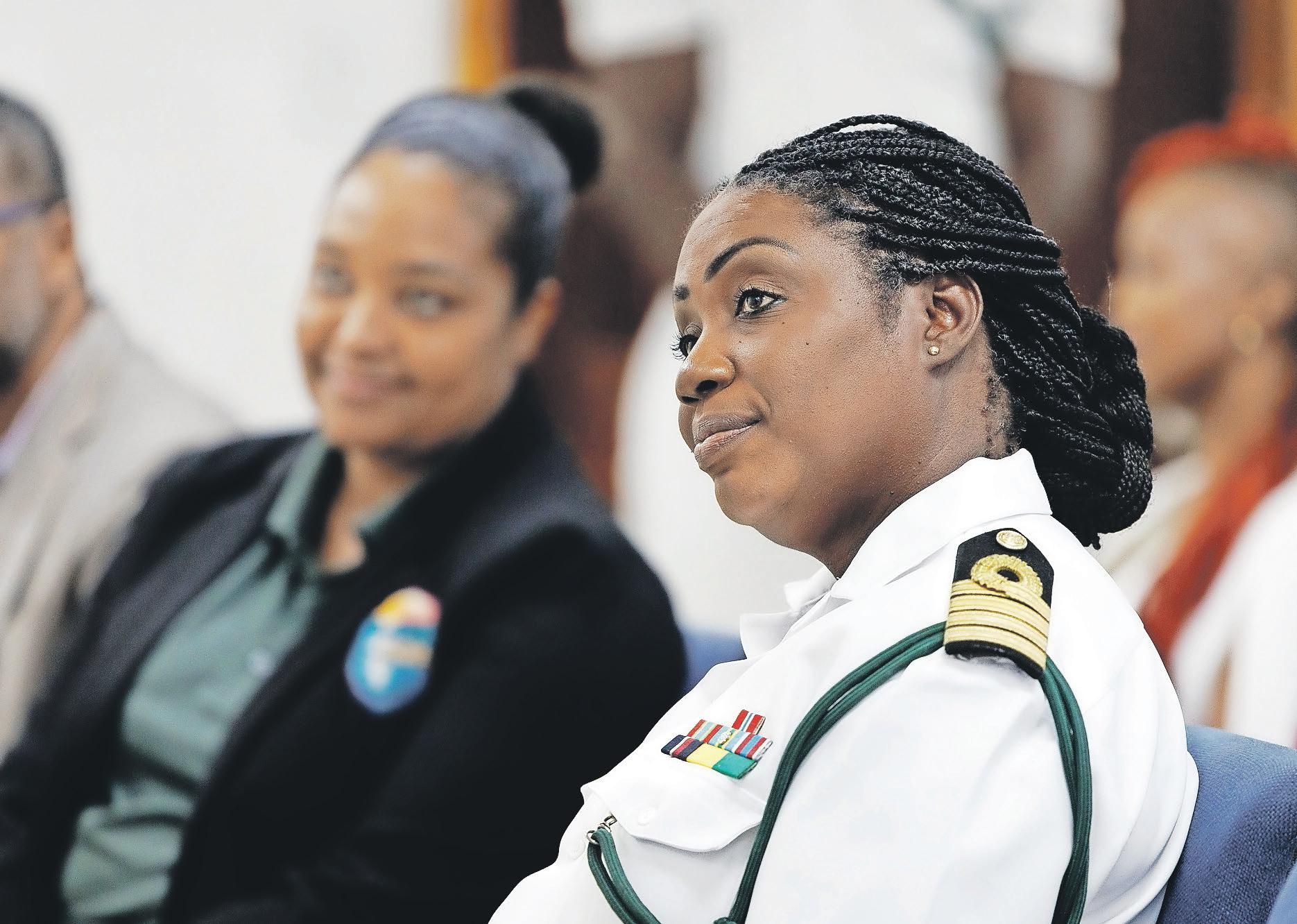













By NEIL HARTNELL Tribune Business Editor nhartnell@tribunemedia.net
THE Opposition voted against the Maritime Revenue Unit Bill over fears it will revive the previously-abandoned Bahamas Moorings deal under the guise of statute legislation.
Adrian White, the St Anne’s MP, said the Free National Movement (FNM) has “many concerns” over legislation designed to provide legal standing to
the already-established Maritime Revenue Enhancement Unit because some of the powers given to it appear eerily similar to what what Bahamas Moorings was attempting to do. The Bill seeks to give the Unit “the power to provide mooring services for a fee”, as well as install moorings, “set a fee structure” for boats who use them, and conduct “safety inspections of moorings”.

By
JADE RUSSELL Tribune Staff Reporter jrussell@trubunemedia.net
A STUDENT’S father attacked a primary school principal with an iron object during a parent-teacher conference in East Grand Bahama on Friday, leaving her hospitalised with serious head injuries, police said.
The Ministry of Education condemned the attack, describing it as an unacceptable act of violence that undermines efforts to keep schools safe. The assault occurred around 10.30am when the man, reportedly upset about his child’s report

By KEILE CAMPBELL Tribune Staff Reporter kcampbell@tribunemedia.net
A SIMULATED Category 4 hurricane hitting New Providence revealed communication and coordination issues within The Bahamas’ disaster response system, officials acknowledged during a national tabletop exercise on Friday.
By JADE RUSSELL Tribune Staff Reporter
jrussell@tribunemedia.net
The three-day drill, led by the Disaster Risk Management Authority (DRMA) at the National Emergency Operations Centre, aimed to evaluate how national agencies would manage preparation, response, and recovery in a high-impact storm scenario. The simulation compressed weeks of emergency procedures into just a few hours, testing the system’s limits under pressure.
Cleavon Nixon, DRMA’s manager of disaster operations, said the exercise showed agencies struggled to communicate effectively during the simulated crisis. He noted that while each agency has its own role, overlapping responsibilities sometimes interfere with coordinated action.
He explained that the goal was to assess how authorities would respond

THE Ministry of Health & Wellness, in collaboration with the Bahamas Department of Meteorology, has issued a stern warning as a blistering heat wave sweeps across the eastern United States and the Caribbean, bringing with it recordbreaking temperatures expected to linger for days. The advisory highlights the heat index, a measure of how hot the heat truly feels to the human body. This
index is projected to spike dramatically, ranging from oppressive levels of 102 degrees Fahrenheit to hazardous levels of 122 degrees Fahrenheit.
In an official statement, the ministry emphasised the growing threat posed by heat waves, which are becoming more frequent, more intense, and longerlasting. The risk is not just discomfort but real danger.
DOG SHOT AND KILLED BY POLICE
KEILE
By
CAMPBELL Tribune Staff Reporter kcampbell@tribunemedia.net
A POLICE officer shot and killed a nursing dog during a foot chase on Saturday morning, sparking outrage from residents who accuse the officer of cursing at bystanders and say the animal didn’t attack.

By JADE RUSSELL Tribune Staff Reporter jrussell@tribunemedia.net
A MAN in his early 20s was shot and killed in front of his home in the East Street South area yesterday, just days after National Security Minister Wayne Munroe said crime is down nationwide.
Police press liaison officer Chief Superintendent Sheria King told reporters the incident happened shortly before 8pm. She said the victim and a group of men were socialising outside a residence on Taylor Drive, off Victoria Boulevard.
Two people on a motorcycle arrived at the residence. One of the bikers got off and opened fire on the victim, fatally wounding him. Chief Supt King said the man was a resident of the home where the group had gathered. No one else was injured.
Police could not confirm whether the victim was known to them. Chief Supt King also said it was too early in the investigation to determine a motive.
This marks the 41st murder for the year, according to The Tribune’s records.
Last week, during his budget debate contribution, Mr Munroe said overall crime, including murder, is down this year. He defended the government’s record amid opposition criticism and public concern over a string of deadly weekend shootings.
He said homicides have decreased by nine percent, with major crimes down across all categories, though he acknowledged the figures remain “too high” for comfort.
Mr Munroe said crimes against the person: including murder, attempted murder, rape, unlawful sexual intercourse, and armed robbery — are down 25 percent. Crimes against property — such as burglary, housebreaking, shopbreaking, stealing, and vehicle theft — have fallen by 11 percent.
He also reported regional declines in crime: 14 percent in New Providence, 14 percent in Grand Bahama and the northern Bahamas, and 19 percent in the Family Islands.
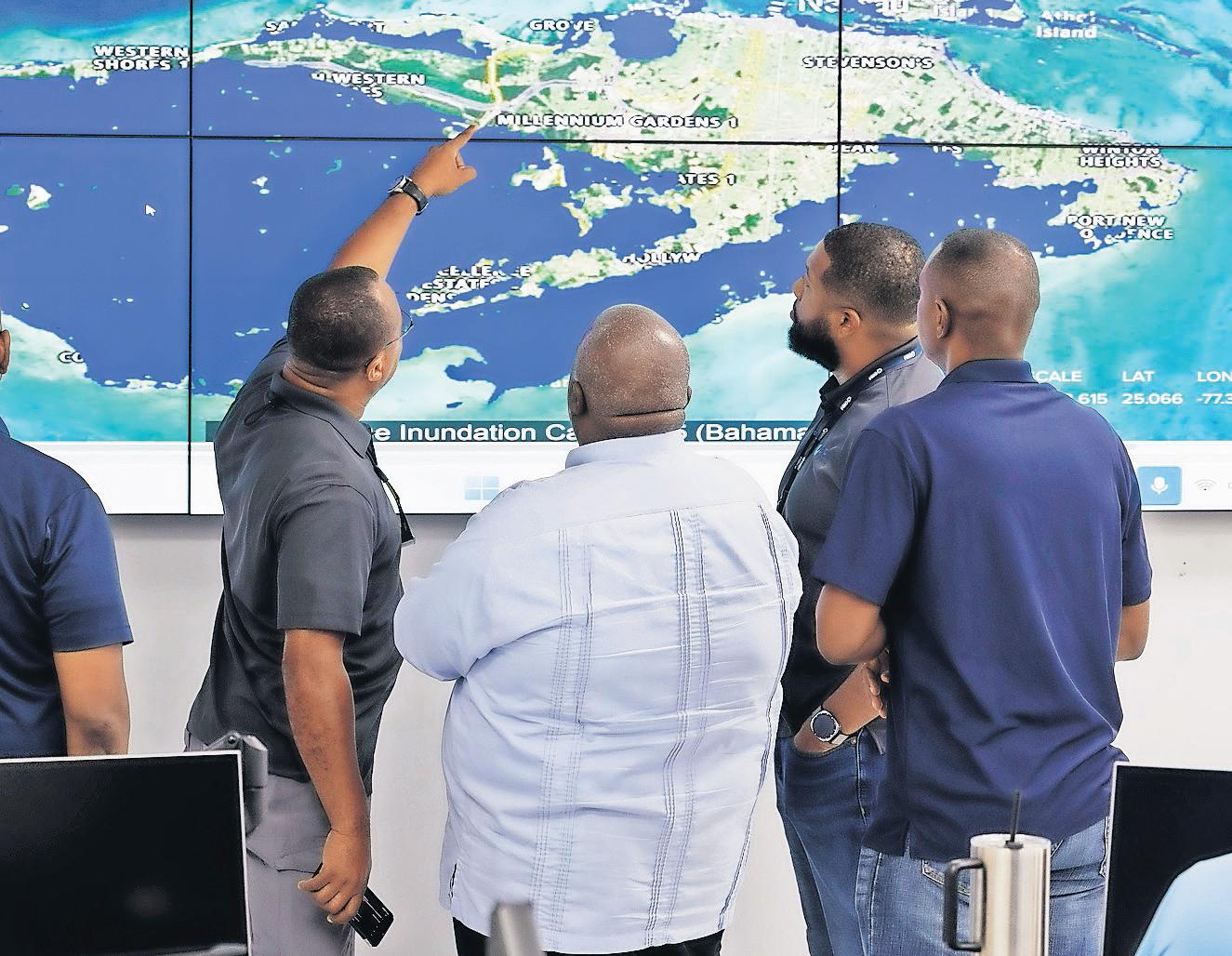
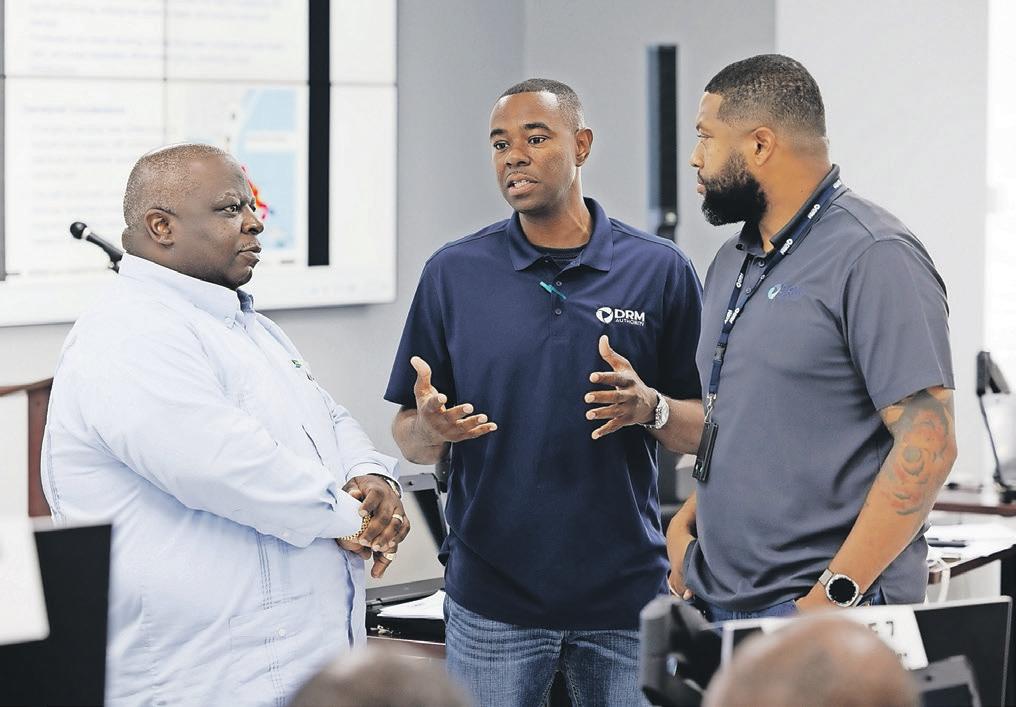

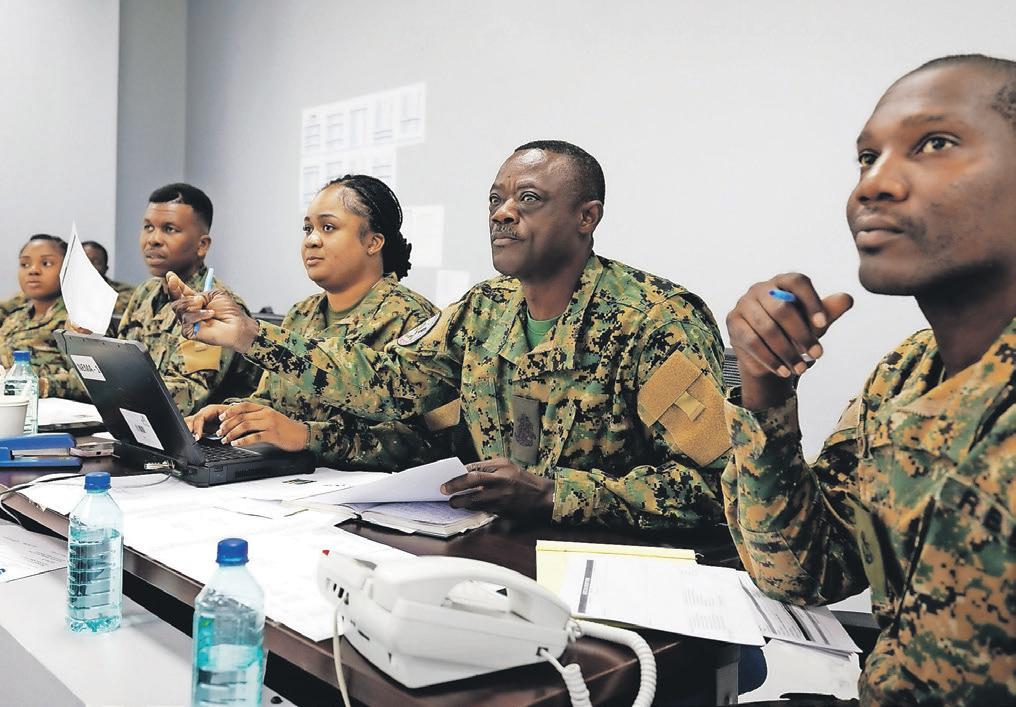
card, allegedly hit the principal during a confrontation on school grounds.
According to police, the woman suffered serious head injuries and was taken to the hospital, where her condition was initially listed as serious but stable. She has since been discharged.
A 27-year-old man was arrested in connection with the incident and remains in police custody. Investigations are ongoing.
In a statement issued over the weekend, the Ministry of Education said: “Schools must be safe places for teaching and learning. Violence of any kind will not be tolerated.”
It added that ministry officials are working with law enforcement to ensure the matter is thoroughly investigated and that appropriate legal consequences follow.
Counselling and other support services have also been made available to staff and students.
The ministry claimed
violent episodes on campus have declined following the return of the School Resource Officer (SRO) programme, operated in conjunction with the police.
“The ministry is also actively reviewing policies concerning access by members of the public to school grounds,” the statement said. Officials have called on parents, guardians and community leaders to help maintain school environments that are safe, respectful and supportive for all.
from page one
The yard the officer entered belonged to an uninvolved family with no apparent ties to the man officers were chasing.
Police said officers were conducting a routine stopand-search on Key West Street when a suspect fled on foot and ran into a nearby yard. There, an officer encountered the dog and reportedly fired her weapon in self-defence after being attacked. She was allegedly treated at the hospital.
However, neighbours allege the dog, described as a potcake and not a
pit bull, merely barked in response to the commotion and did not attack. They say the shooting occurred in the presence of small children and near a litter of the dog’s puppies, some of which were seen attempting to nurse from their dead mother’s body.
“This was not a pit bull,” one resident said. “It was a potcake. You go in somebody yard, of course the dog will bark. That is normal.”
Neighbours said the dog had recently given birth and was typically leashed in the yard.
Residents accused the officer of using abusive language after the shooting.
One neighbour said: “When I told her there were children in the yard, she started cursing me. That is bad. I do not appreciate that, especially from someone in uniform.”
Questions also surround the police’s version of the chase. While officials claim the pursuit stemmed from a stop-and-search involving a group of men, several residents say officers initially stopped a woman driving a vehicle before shifting focus to a man who had not been involved.
“They was doing stuff with somebody else,” one witness said. “They see somebody they recognised then chased him down.”

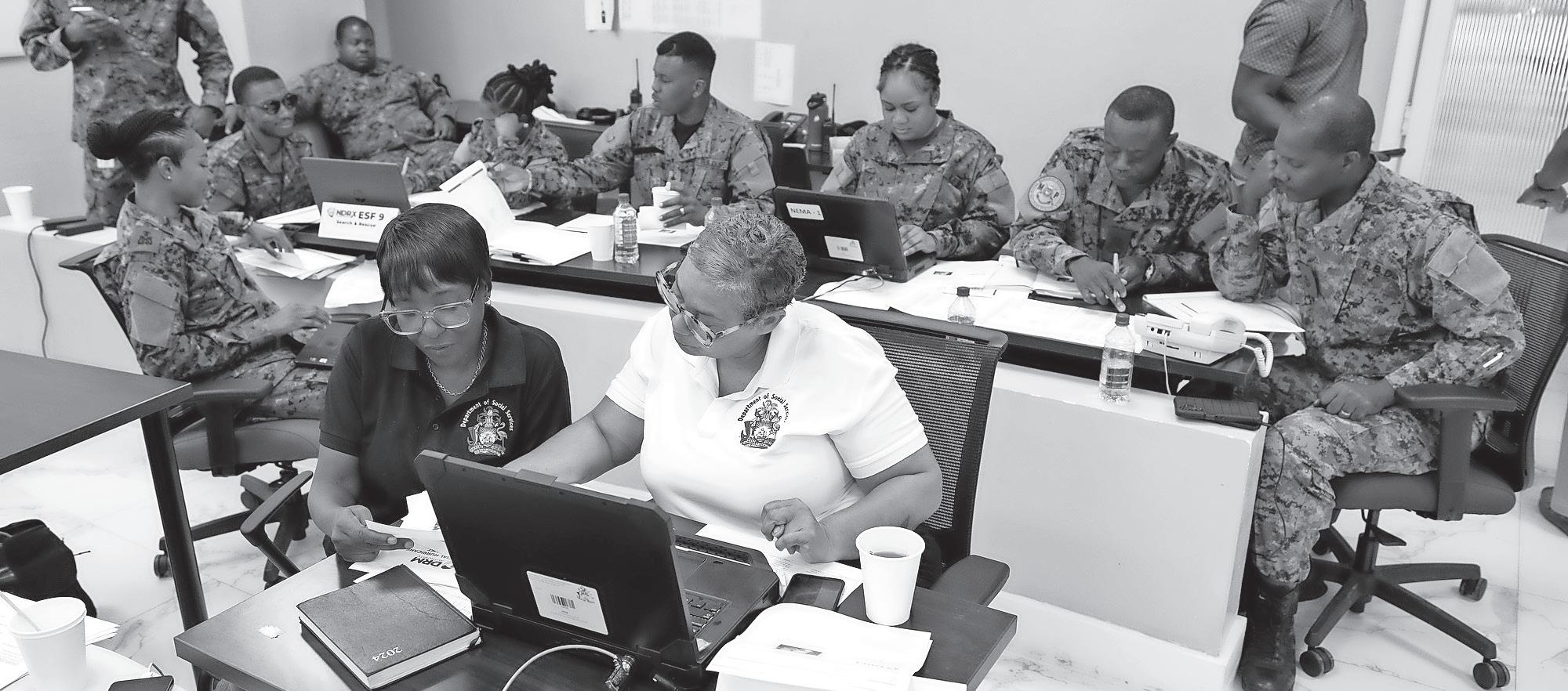
from page one
respond if New Providence itself were severely hit while still needing to assist the Family Islands and request international help.
Aaron Sargent, DRMA’s managing director, said the drill reflected a broader shift in how the agency will manage national emergencies under new legislation, including structural changes to how the emergency centre functions during disasters.
He highlighted assistance from the US Forestry Service in developing a new operational framework and said tools like a national alert system, similar to the Marco Alert, are in development. The platform will allow emergency messages to be sent directly via SMS to every

mobile phone holder in the country.
Mr Sargent said the DRMA is also working with partners on rapid communication technologies to strengthen early warnings and response during crises. Jenna Daggett, Bahamas programme manager at US Northern Command, emphasised the importance of building joint capacity across the region. “If
we’re all stronger, we can all respond to those shared challenges together,” she said.
Mr Nixon stressed that climate change is making hurricanes harder to predict and prepare for. He recalled how Hurricane Oscar developed with little warning last year. “We went to bed Friday night with a 20 percent chance of any formation,” he said. “Woke up the next morning... getting a call from the Met Office to say, hey, we have to issue now a hurricane warning for the southern islands.”
He added: “My message is simple, do not wait.”
Further tabletop exercises are planned in four Family Island regions, with officials using insights from the drill to revise disaster response and communication strategies.
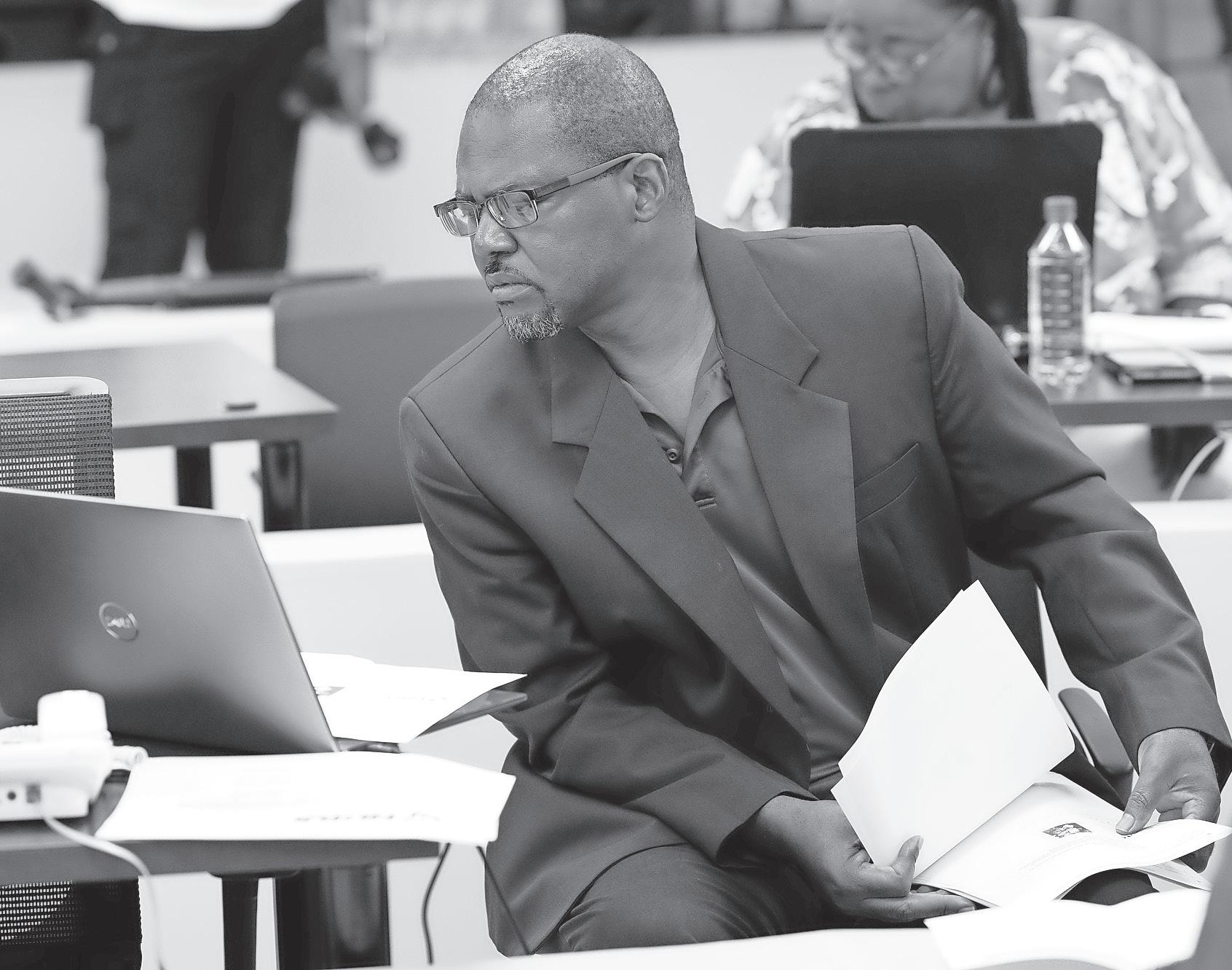
By KEILE CAMPBELL Tribune Staff Reporter
kcampbell@tribunemedia.net
A $2.5M PLAN to refurbish a seized King Air 350 aircraft for government use has been quietly shelved after officials deemed the plane unfit for investment, National Security Minister Wayne Munroe confirmed during the 2025/26 budget wrap-up in the House of Assembly. The aircraft, previously intended to assist Royal Bahamas Defence Force (RBDF) operations and inter-island government travel, has now been placed in the Confiscated Asset Fund and will be dealt with under the Proceeds of Crime Act.
was not feasible to do so,”
Mr Munroe told Parliament on Thursday, referencing plans to convert the aircraft for official missions. He clarified that none of the $2.5m previously earmarked for the project had been spent.
“When it was examined, it was determined that it
“Finance allocated it for that purpose. The purpose did not come to pass. So it was not used,” he said. Controversy erupted
last year over the plane.
The Office of the Prime Minister described the aircraft as a cost-saving tool to address delays faced by technical teams and officials travelling to remote Family Islands.
At the time, officials pointed to two-to-threeday waits for return flights and the growing expense of accommodation and per diems as justification
for refurbishing the aircraft.
The Royal Bahamas Police Force was expected to oversee the plane’s maintenance and operations, with plans to enhance logistical capacity in a country spanning hundreds of islands.
Minister of State Leon Lundy had touted the aircraft as a practical solution to inter-island travel
inefficiencies, especially given the irregularity of commercial flights. But during last week’s debate, Free National Movement MPs Adrian White and Shannondon Cartwright raised concerns about the missing line item in the 2025/26 budget estimates. They questioned the status of the aircraft and the unaccounted $2.5m.
from page one
for armed robbery. Bevans received a 48-year sentence.
The convictions stemmed from a 2016 incident in which Richards, 48, was shot multiple times at Bonefish Pond National Park. His body was later discovered by police, who also found his vehicle, condoms and a woman’s skirt near the crime scene.
A jury of nine convicted both Johnson and Bevans in July 2022.
During her appeal, Johnson argued that the trial judge erred by ruling she had a case to answer and by allowing hearsay evidence. She also identified herself as the deceased’s girlfriend. Although Justice Smith dissented, the majority upheld Johnson’s appeal on the grounds that the trial judge should have allowed the jury to consider alternative verdicts of manslaughter or robbery. The court found that prosecutors had failed to prove Johnson intended to kill Richards or assist the gunman in doing so.
As a result, the Court of Appeal quashed her murder and armed robbery convictions and ordered a new sentence for robbery to be determined on October 7.
In her ruling summary, Senior Justice Cheryl
Grant-Thompson had noted that Johnson maintained her innocence throughout the trial, claiming she was in a sexual relationship with Richards and that they had been intimate at the park when a man dressed in white and armed with a handgun robbed the victim. Johnson said she fled in a state of undress after hearing a gunshot and seeing Richards collapse in a pool of blood. She took a bus home and did not report the incident, later claiming fear for her safety. She was arrested days later. The co-accused gave conflicting accounts of the incident and denied knowing each other prior to their arrests. During trial testimony, a senior police officer said Johnson had told investigators she received a call from a man named Ramond Gibson while she was with Richards and revealed their location. According to the officer, she admitted Gibson said he intended to rob Richards. Johnson later claimed the statement was made under duress and that Gibson had threatened her and her children.
Justice Grant-Thompson had characterised the crime as “heinous” and a “coldblooded” act, saying: “Mr Scott Richards was robbed, shot and left to die on the ground, like an animal.”
She also criticised the impact on the crime scene, calling it a desecration of a once-picturesque setting.
She acknowledged Johnson’s expression of sympathy to the victim’s family but noted that neither accused showed genuine remorse.
While she concluded that Johnson was capable of rehabilitation, she described the crime as “abhorrent”.
Justice Grant-Thompson said Bevans was not of good character, citing his prior armed robbery convictions and an unrelated
prison sentence he is currently serving. A probation report also alleged Bevans confessed to murdering a pastor at an ATM, though the judge said this unverified claim had no bearing on the ruling.
Justice Grant-Thompson
had said she intended for sentencing to send a clear message that such conduct is “unacceptable” in society. Johnson was represented by Nathan Smith. Terry Archer appeared for the Office of the Director of Public Prosecutions.

By JADE RUSSELL Tribune Staff Reporter jrussell@tribunemedia.net
PRIME Minister Philip “Brave” Davis delivered a blunt directive to the Department of Social Services on Friday, calling on staff to treat every person seeking assistance with dignity, not scepticism.
Speaking at the commissioning of the department’s newly renovated headquarters at Sunshine Plaza on Baillou Hill Road, Mr Davis said too many Bahamians have had to fight for survival in a system that makes them feel forgotten. He noted that the government’s responsibility is to dismantle such barriers, not reinforce them.
He acknowledged that the work carried out by the department can be emotionally demanding but added that people in need should be met with empathy and respect, not red tape and indifference.
“When you walk into the Department of Social Services, you should be met with respect, not suspicion; with warmth, not bureaucracy. If someone is coming to you for help, chances are they’ve already been through enough,” Mr Davis said.
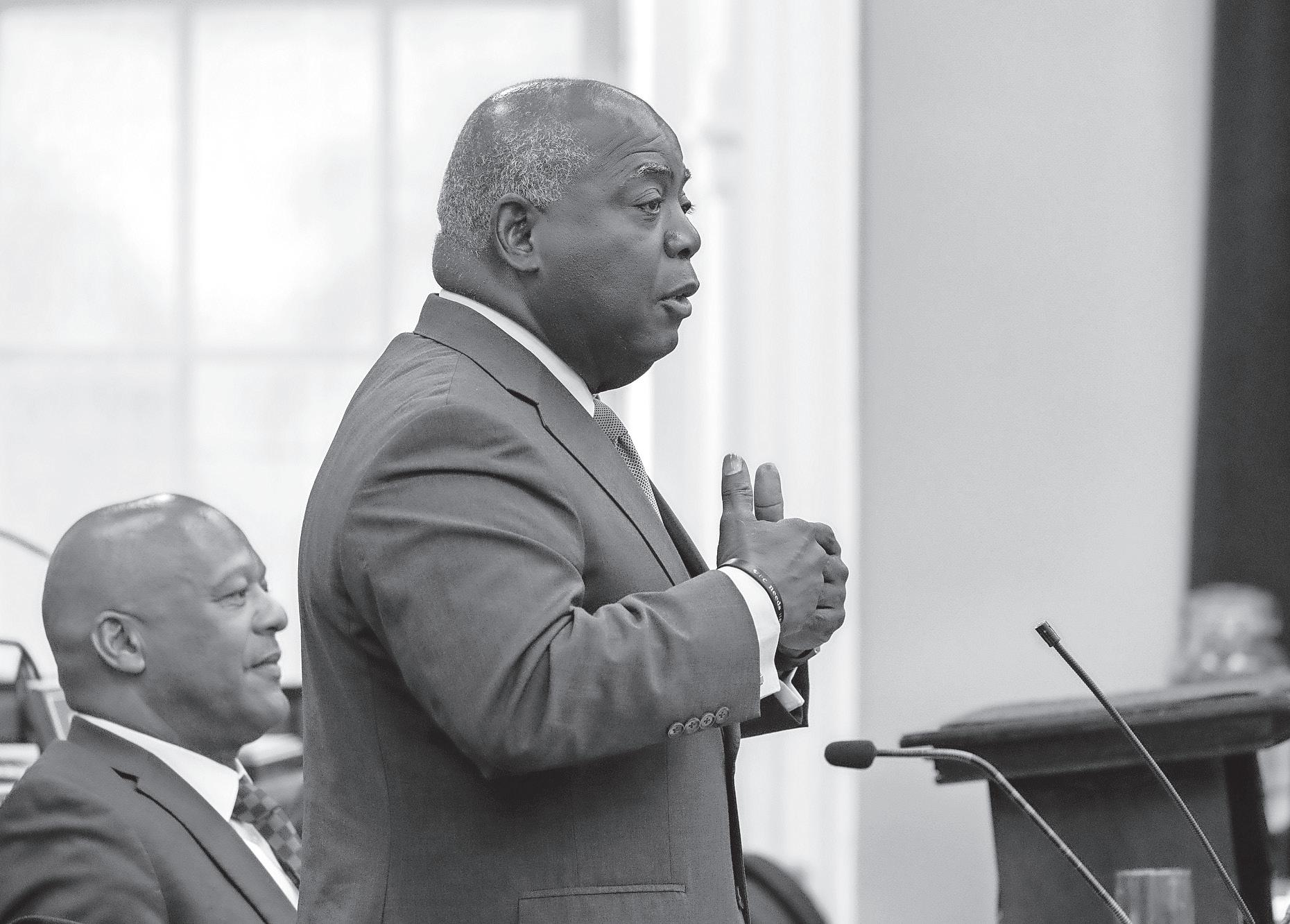
His comments come amid long-standing public complaints about dismissive or rude treatment by ministry staff. Some residents have reported waiting hours
only to feel judged or leave empty-handed. Mr Davis said the government is committed to doing everything possible to support the vulnerable.
made clear that the physical space was secondary to its purpose.
“I couldn’t care less about the paint on the walls or the size of the conference room,” he said. “What I care about, what I will always care about — is how we treat people.”
Minister of Social Services Myles Laroda acknowledged that some of the complaints about staff conduct were valid.
However, he pointed to the department’s ongoing work to provide food, rental, clothing and other forms of support.
Mr Laroda said the headquarters upgrade is the first of three phases aimed at modernising service delivery.
“I look forward to the completion of the remaining phases and the finished product, a state-of-the-art head office that we can all be proud of,” said Mr Laroda.
By KEILE CAMPBELL Tribune Staff Reporter kcampbell@tribunemedia.net
OPPOSITION Leader
Michael Pintard has blasted the government’s push to establish a statutory Maritime Revenue Unit, warning it represents
a quiet takeover of roles currently handled by the private sector and lacks public consultation. The bill, passed Thursday during the House of Assembly’s afternoon session, formalises oversight of mooring fees, licensing, and maritime infrastructure. It comes months after the government was forced to cancel a controversial seabed lease granted to Bahamas Moorings Ltd without public tender. Mr Pintard accused the Davis administration of overreach, suggesting the

He added that if that means cutting bureaucracy or finding additional funds, then those steps must be taken. He said he would rather the government be criticised for doing too much than remembered for doing too little.
While the opening of the newly renovated facility was celebrated, Mr Davis
He also noted a growing demand for social assistance. In Parliament in March, Mr Laroda reported that the department had spent $6.8m on aid in New Providence as of December 2024. That included $2.6m for food, $1.6m for temporary accommodation, and $731,000 in medical support.
new unit would duplicate services already managed by private firms, particularly waste removal from vessels.
He called on the government to withdraw the bill and consult stakeholders before moving forward, arguing there was no clear justification for its sudden advancement.
Prime Minister Philip Davis rejected the appeal, saying the new legislation gives statutory authority to a unit already operating under the Ministry of Finance. He said the intent is to bring uniformity to maritime regulation and direct revenues to Family Island local governments. Regulatory consultations, he said, would come after the bill’s passage.
Mr Davis defended the move by citing unchecked marine activity. He recalled seeing dozens of boat lights offshore without any apparent oversight.
The bill’s passage follows a firestorm over a 21-year seabed lease signed by
Mr Davis earlier this year. The deal gave Bahamas Moorings Ltd permission to install up to 250 private mooring buoys in the Exuma Cays, a contract critics condemned as profitdriven and opaque. The arrangement was abruptly scrapped in February after officials acknowledged missing permits, prompting pledges of reform and transparency from the Prime Minister’s Office.
Debate over maritime regulation resurfaced during budget discussions, where Long Island MP Adrian Gibson questioned whether $2.25m set aside for vessel removals this year mirrored last year’s allocation and if any meaningful progress had been made.
He highlighted derelict boats that remain hazards in New Providence Harbour and other areas. New Providence vessels that hadn’t moved in years, he noted, continued to block access and pose risks.
Transport Minister
JoBeth Coleby-Davis confirmed that removals are ongoing in New Providence and Family Islands like Andros and Abaco. She said her ministry is working with vessel owners and the Attorney General’s Office to resolve outstanding cases legally and efficiently.
St Anne’s MP Adrian White pressed for clarity on whether funds would also cover the removal of a tugboat and barge sunk near protected reefs in Abaco. Mrs Coleby-Davis confirmed discussions are underway between relevant authorities and said a recent meeting addressed possible solutions.
Mr White then asked for an accounting of last year’s $3.4m budget for vessel removals, questioning where that money went given the visible lack of results.
Mrs Coleby-Davis responded by criticising the previous administration, claiming it had failed to act on the same maritime issues.


By JADE RUSSELL Tribune Staff Reporter jrussell@tribunemedia.net
THE government has received SpaceX’s postlaunch report following its historic Falcon 9 booster landing in Bahamian waters earlier this year, with officials saying the operation caused no significant environmental harm.
Dr Rhianna Neely, director of the Department of Environmental Planning and Protection (DEPP), said her department is also reviewing a first draft of the Environmental Impact Assessment (EIA) required for any future landings. The post-launch report is expected to be made public
within the coming week. The documents follow Deputy Prime Minister Chester Cooper’s April announcement that SpaceX would not be permitted to carry out further landings in The Bahamas until a full EIA was completed and a post-launch assessment submitted.
While the Environmental Baseline Statement (EBS) released earlier this year by local consultancy BRON predicted only minimal disruption to marine life, environmentalists argued that a comprehensive EIA was still necessary.
Dr Neely said the post-launch report has reinforced earlier findings.
“This is what was
communicated with the general public prior to the reentry exercise,” she said. “That based on the documents that were provided to the department, it was not likely that there would be any negative short-term or long-term impacts to the environment, so the postlaunch report essentially confirms, verifies what was said before the reentry exercise.”
Despite the favourable outcome, she acknowledged that officials found gaps in how the assessment was conducted and in the length of time it covered. These shortcomings, she added, will be addressed in future evaluations.
Dr Neely declined to
from page one
“The increasing frequency, duration, and intensity of heat waves raise the risk of heat-related illnesses and even death,” the ministry said. These ailments can start mildly, with heat cramps and fatigue, but may escalate into severe symptoms such as dizziness, fainting, and excruciating body cramps—particularly after physical exertion.
Vulnerable groups remain on high alert. The elderly, children, and individuals with underlying health conditions are at increased risk, prompting urgent calls for vigilance and self-care.
Officials urge residents to take immediate steps to safeguard their wellbeing: stay indoors during peak heat hours, hydrate frequently, dress in light, breathable fabrics, shield yourself with hats and sunscreen, and avoid strenuous outdoor activities.
The Bahamas is no stranger to such brutal heat.
In July 2023, the country endured record Heat Index readings, setting off alarms across the health and animal welfare sectors. At the time, chief meteorological officer Patricia Weeks foresaw that the heat was only set to intensify. Amid last year’s crisis, animal welfare advocates also raised the alarm.
Bahamas Humane Society president Kim Aranha implored pet owners to recognise the signs of heat distress in animals.
“If your animal is showing any form of distress, lethargy, throwing up, won’t eat, won’t drink, that could be a sign of heat stroke,” Ms Aranha warned. “One of the first things to do is try to get them cooler. Put ice on their neck, just like you would with a human. Put a cool towel on their tummies. Get their temperature down as soon as you can and call a vet. Various vets have told me that they have seen cases of heat stroke come into their offices.”

draw early conclusions about the draft EIA, noting that her department had only just received it.
SpaceX has said it hopes to complete the EIA by the end of summer and resume booster landings soon after.
Speaking at an April press
conference in Nassau, SpaceX vice president of launch Kiko Dontchev said the company had taken concerns from environmental groups into account as part of its review process.
On February 18, The Bahamas became the first
Read The Instructions stationed in the Exuma Sound.

NULLIUS ADDICTUS JURARE IN VERBA MAGISTRI
“Being Bound to Swear to The Dogmas of No Master”
LEON E. H. DUPUCH
Publisher/Editor 1903-1914
SIR ETIENNE DUPUCH, Kt., O.B.E., K.M., K.C.S.G., (Hon.) LL.D., D.Litt .
Publisher/Editor 1919-1972
Contributing Editor 1972-1991
RT HON EILEEN DUPUCH CARRON, C.M.G., M.S., B.A., LL.B.
Publisher/Editor 1972-
Published daily Monday to Friday
Shirley & Deveaux Streets, Nassau, Bahamas N3207
TELEPHONES
News & General Information
(242) 502-2350
Advertising Manager (242) 502-2394
Circulation Department (242) 502-2386
Nassau fax (242) 328-2398
Freeport, Grand Bahama (242)-352-6608
Freeport fax (242) 352-9348
WEBSITE, TWITTER & FACEBOOK
www.tribune242.com



@tribune242 tribune news network
A HEAT advisory was issued yesterday by the government.
It is timely – but what it lacks is detail on the government response for those who are most in need.
The message, in fairness, came from the Ministry of Health and Wellness. Action in response would most likely lie in the hands of Social Services.
We point out the situation because just under two years ago, we reported on how some of the country’s poorest residents struggle not just to deal with the heat, but to exist at all.
A street vendor talked of how he had seen two people faint in the heat. A homeless man collapsed under the sweltering sun on Mackey Street. Another homeless man talked of how he always felt the discomfort outside.
At the time, Bishop Walter Hanchell, said: “If you can’t afford a standby generator or AC, then man, all you gonna do is suffer, and that’s all we’ve been going through. If it’s affecting the middle class, you could imagine what the poor is going through in those hot houses, those small houses with no ventilation.”
The official warning says the public is advised to pay attention to the heat index. Forecasters expect a “brutal” heat wave across the eastern US and Caribbean this week, with several days of record high temperatures.
The warning said: “Illnesses can range from mild symptoms such as heat cramps and exhaustion to dizziness and fainting spells, to painful body cramps at
the end of an extended exercise routine. If at any point you become confused, extremely drowsy or unconscious you need to seek emergency medical help.
Heat stroke can be fatal if not treated properly. Vulnerable populations, including the elderly, children, and those with pre-existing health conditions, are particularly susceptible to these dangers.
“Health officials are advising the public to keep cool and well hydrated, limit time spent outdoors, wear light breathable clothing, wear a head covering and sunscreen.”
Good advice, certainly, but for those who do not have a roof over their heads, we hope Social Services will give some thought to how they can be assisted.
Even just providing bottles of water to the homeless would be a helpful act, as well as some steps to offer shelter through the worst of the heat if possible.
This is after all a changing world. In The Tribune this week, we include our hurricane preparedness guide – and we have certainly seen much talk about how climate change is heating up our world.
Perhaps the day will come when we must consider not just hurricane shelters, but heat shelters – places where those who have nowhere else to go, or whose homes simply cannot cope with the heat and who have no fans or AC, can seek respite for a while.
These are the things to consider as our world continues to heat up – but for now, stay cool as best you can, and help those who are most vulnerable.
EDITOR, The Tribune.
WAYDE Watson stood up during the 2025/2026 Budget Communication and had the nerve to talk about the previous MP abandoning Bain & Grants Town?
Wayde, let me tell you something as a born and bred voter in this community: the only thing that’s truly abandoned us is your leadership.
Say what you want about the last representative, we’re still riding on the fruits of his efforts of bringing A World Class Cruise Port(YES Foundation), Parks, Programmes, Scholarships, and Community Initiatives that actually meant something. He might’ve been far from perfect, but at least he showed up and had something to show for his time! You? You came in with a smile and a shirt and gave us scandals, silence, and shame. While Bain and Grants Town cried out from
murders and for jobs, mentorship, better schools, and safer streets, you were busy ducking allegations and hiding behind party colors. All we’ve gotten from you are alleged accusations about preying on young women, girls in the community just looking for a chance, not to be exploited. That’s not representation, that’s reputation destruction. We are already struggling with a bad name, then came you to rob us of whatever dignity we’ve got left.
Mr Watson, you talk about abandonment, but you’ve abandoned your duty. We don’t see you unless it’s a press photo or a PLP parade. The same people you ignored, insulted, and intimidated are the same ones you’re now begging for votes. Let me be real with you. Yes, when campaign season comes — we’re going to take the shirts. We’re going to eat the food.
We’ll smile, nod, and take the money.
But in that voting booth, we’ll do what you failed to do, we’ll stand for Bain & Grants Town!
Because this community is tired of being used and forgotten. We are tired of being blamed and shamed. We are tired of being led by someone who should’ve never been allowed to lead in the first place.
Come Election Day?
You’ll finally be able to focus full time on what you’ve been doing part-time all along, just explaining yourself!
This isn’t Bain Town anymore. This is Blame Town, and “we know exactly who to blame.”
And it’s not the last MP.
It’s you, Wayde. And your time is up!
MOTHER GIBSON
Bains & Grants Town Resident & Voter Nassau, June 20, 2025.

EDITOR, The Tribune.
PRESIDENT Donald Trump’s decision to destroy Iran’s three nuclear sites on Saturday at Fordo, Natanz and Isfahan has set off another round of criticisms aimed at the current Jewish state in Palestine and its Prime Minister Benjamin Netanyahu. Two GBU-57 Massive Ordnance Penetrators (MOPs) were dropped on the Iranian sites in a well-planned clandestine operation sanctioned by Trump. And the now the world awaits the possible response of Iran’s Supreme Leader Ayatollah Khamenei, who has reported to have gone underground in hiding. Israel has not ruled out the possibility of carrying out an assassination attempt. Iran has a population of over 90 million.
Over 99 percent of Iranians are Muslim, with between 90 and 95 percent belonging to the Shia denomination, and about five percent being Sunni. If this latest skirmish leads to an all-out war, The Bahamas will undoubtedly feel the negative effects, in terms of an expected drop in tourist arrivals. I am old enough to remember what happened subsequent to the September 11 attacks on America and the First Persian Gulf War about 35 years ago. The Bahamas has never diversified its economy to the degree that it can survive if its main industry plummets. Moreover, we are unable to feed ourselves, having to depend on food imports from the US, the same nation that many Arab and Persian
Muslims have derogatorily labeled the Great Satan. The church in The Bahamas must pray that the Sovereign Lord will intervene. As a Bahamian evangelical, I am very alarmed at the many nasty, vitriolic and hateful comments by young Bahamians towards the Jewish state. I am seeing far too many Bahamians side with Islam and its ideological war with the Western hemisphere, the US and Israel. Too many Bahamians are now flirting with antisemitism, recklessly claiming that the Israelis living in Palestine are not really Jews. This is a claim often made by Black Hebrew Israelites, Black Muslims and perhaps members of the cult Church of Jesus Christ of Latter-day Saints. I believe the late Worldwide Church of God cult founder Herbert W Armstrong also promoted a British Israelism hypothesis, that says that the ten lost tribes of Israel are the Brits and white Americans. I stand to be corrected, however. While I don’t support the Christian Zionism of American televangelist John Hagee, as he has been accused of promoting an heretical dual covenant theology that has unbelieving Jews in right standing with the Lord, I do recognize that Israel is still God’s ancient elected people whom He will save at some point in the distant future according to Romans 11:26.
God still has a plan for Israel. Its rebirth in May 1948 after two millennia of living as a dispersed people since AD 70 is nothing short of miraculous.
Those Bahamians who are calling Israel to be punished because, according to them, they had initiated this skirmish with Iran, have conveniently ignored the role Iran played in the October 7 attacks on Israel. Iran has used its proxies in Hezbollah and the Houthis in Yemen to do its dirty work. Israel has decided to go right after the head instead of just targeting those doing the bidding of the Ayatollah. I am warning those young Bahamians who are using social media to spread hate towards the Jewish people to be very careful. Zechariah 2:8 says that Israel is the apple of God’s eyes. Yes, I understand that Romans 2:28-29 and Galatians 6:16 speaks about the spiritual Israel of God, which is the New Testament Church comprised of Gentiles and Jews. Yet Scripture nowhere denies the reality of national, physical Israel. Romans 11, which was written two thousand years ago, assumes that the physical descendants of Abraham, Isaac and Jacob would be alive around the time of the second coming of Jesus Christ. I am appealing to those Bahamians who are espousing antisemitism to give strong consideration to abandon their dangerous ideological position.
KEVIN EVANS Freeport, Grand Bahama June 22, 2025.
EDITOR, The Tribune.
AS the country witnesses the fourth budget debate of this administration, and with September marking four years since this government assumed office, it is time for a sober and honest assessment of parliamentary performance, particularly in the House of Assembly. At this stage, no Member of Parliament or Senator can reasonably be called a “rookie”. They’ve had ample time to learn the ropes, master parliamentary procedure, and fulfill their sacred duty: to represent the people with vigor, substance, and accountability. And yet, the overall quality of representation remains abysmally lackluster.
In the House of Assembly, there are a few steady hands.
Prime Minister Davis, along with seasoned veterans like Fred Mitchell, Glenys Hanna Martin, Alfred Sears, and Chester Cooper, consistently offer thoughtful, substantive contributions. They are well-versed in the rules and capable of maintaining the decorum and structure the House demands. A second tier of capable MPs: Wayne Munroe, Keith Bell, JoBeth Coleby-Davis, Pia GloverRolle, Ginger Moxey and Clay Sweeting also rise to the occasion with some regularity.
But that is a mere 11 MPs out of the government’s 33. The rest? Distressingly silent or severely underwhelming. A large number of government MPs including Leo Lightbourne, Kingsley Smith, Vaughn Miller, Basil
McIntosh, Jamahl Strachan, Kirk Cornish, Bacchus Rolle, Sylvannus Petty, Wayde Watson, Leroy Major, and Leon Lundy have perhaps spoken only a handful of times over four years. The average Bahamian would struggle to recall a single word spoken by them in Parliament. This is not what representation looks like. Others such as Lisa Rahming, Leslia Brice, McKell Bonaby, Myles Laroda, Zane Lightbourne, and Mario Bowleg do command attention occasionally. However, far too often they appear to be reading from prepared scripts, with little depth, engagement, or spontaneity. McKell Bonaby, for example, in his recent budget contribution, made no mention of his portfolio. This disconnect between office
and output is unacceptable. In the Senate, the picture is only slightly better. The silence of Senators like Tyrel Young, Roni Duncombe, and Erecia Hepburn mirrors the House’s issues. Yet, there are bright spots. The Attorney General, Ryan Pinder, is consistently articulate and commanding. Barry Griffin distinguishes himself with sharp research and high-quality contributions. Leader of Government Business Senator Michael Halkitis does his job ably leading most debates, and Darron Pickstock contributes meaningfully when he speaks. Honorable mentions must also go to Senators Randy Rolle, James RolleTurner, and Kirkland Russell for their supporting roles in the chamber. But the broader issue
remains: we are not getting the depth of representation we deserve. Parliamentarians are not elected or appointed to warm seats or tally head-counts. They are entrusted to be the voice of the people, to robustly debate, to challenge, to explain, and to lead. Far too many have fallen short. This is a word for Prime Minister Davis. As leader, he must set a higher standard for parliamentary representation. Future candidate selections, especially for key ministerial posts and appointments to the Senate, must prioritize ability over loyalty, performance over persona. We need MPs and Senators who not only read a prepared speech, but who think clearly, debate robustly, and lead confidently. We
need representatives who understand their portfolios deeply, who can respond to questions extemporaneously, and who have taken the time to master the rules of procedure to advance the government’s agenda. It is time to end the era of appointing friends and cronies who cannot hold their own in Parliament. As we move toward the next general election, the focus must shift toward elevating highperforming senators and identifying competent newcomers with the intellect, discipline, and presence to raise the standard in both the House and the Senate. Our democracy deserves nothing less.
C COAKLEY Nassau, June 20, 2025.
By JADE RUSSELL Tribune Staff Reporter jrussell@tribunemedia.net
POLICE Commis-
sioner Shanta Knowles has pushed back against accusations that the Royal Bahamas Police Force gives preferential treatment to investigations involving its own officers, maintaining that all homicide cases are handled with the same urgency and care.
The defence comes in the wake of public criticism from the family of Quintero Arnett, whose murder in February remains unsolved. His mother recently questioned why the force appeared to respond more aggressively following the recent killing of Reserve Inspector Lernex Williams, who was fatally shot during an attempted armed robbery in Palmdale on June 15.
In the aftermath of Inspector Williams’ death, police mobilised an islandwide manhunt and stepped up patrols across New Providence, actions that some have contrasted with the slower pace of developments in other cases. Police officials had suggested they expected to solve the crime quickly precisely because an officer was killed.
Commissioner Knowles said on Friday that while there has been little progress in Arnett’s case, it remains an open investigation. She noted that no homicide case is ever closed without resolution, and there is no statute of limitations on such crimes.
She dismissed the suggestion that any case takes priority based on the victim’s occupation or status and said families like Arnett’s are always
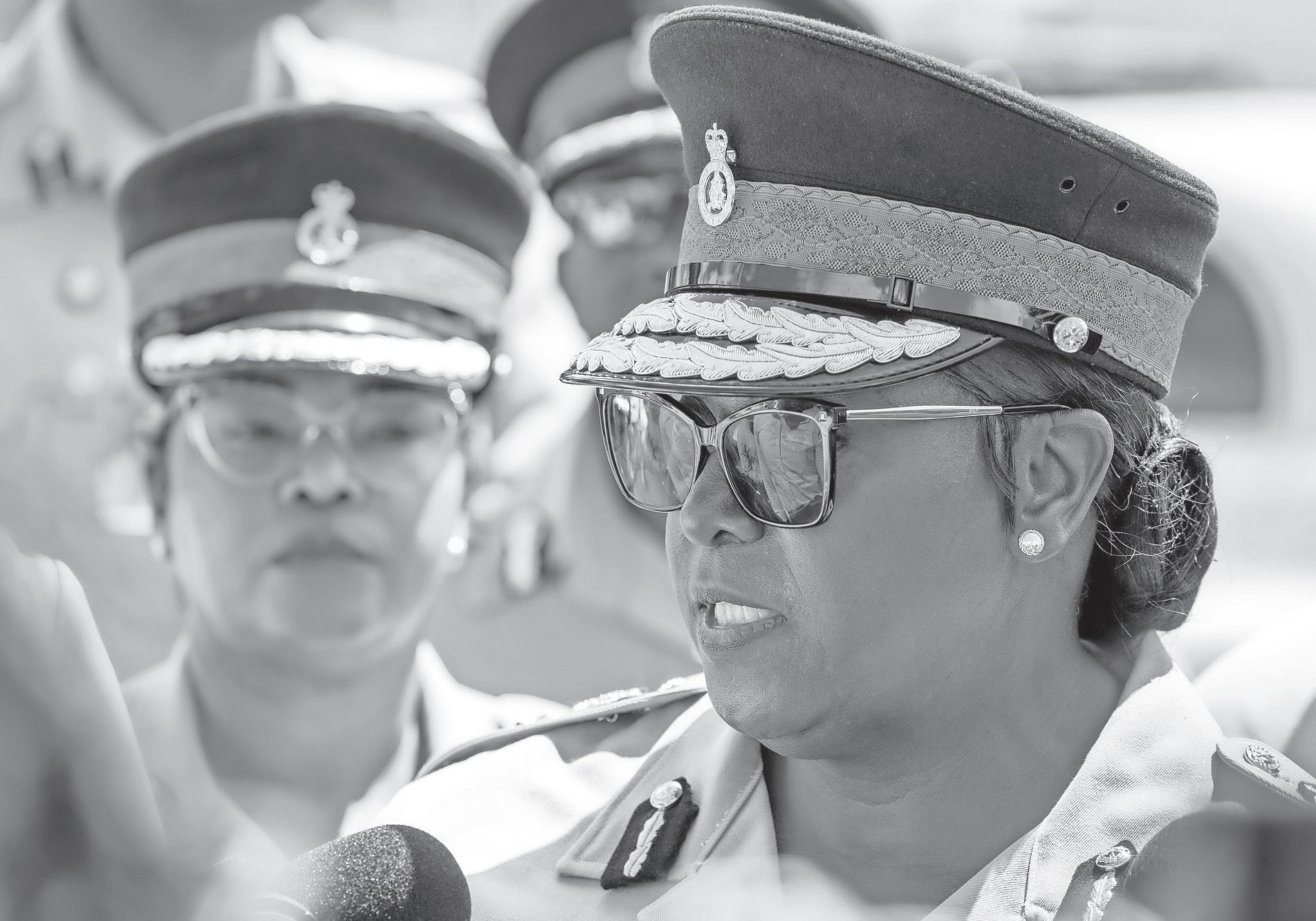
welcome to visit a police station for updates on ongoing investigations. “We take all matters seriously. None is more important than the other. We are here to serve the Bahamian people, and not a specific grouping of Bahamian people,” said Commissioner Knowles. Arnett was killed in front of his girlfriend and young daughter while stopping for breakfast. The brutal
early morning shooting, caught on CCTV, prompted widespread outrage, particularly after footage showed the child fleeing as gunmen continued firing. Relatives have said they do not believe Arnett was the intended target.
Commissioner Knowles made her remarks during the opening of the newly renovated Department of Social Services headquarters on Baillou Hill Road.
She also acknowledged that despite a measurable decline in major crime, public fear remains a concern. While she emphasised that the force remains active and visible across communities, she accepted that fear often persists even in the face of improved statistics.
“We know that crime is down, but we do know that there are still some who are fearful,” she
said. “We just want you to know that the Royal Bahamas Police Force and all its members are out in the streets, and we will continue to protect and serve our people.”
National Security Minister Wayne Munroe, in his budget contribution to the House of Assembly, said homicides had fallen by nine percent and overall major crime was down across all categories this
year. However, he acknowledged that the current figures remain “too high” for comfort. He said crimes against the person, such as murder, attempted murder, rape, unlawful sexual intercourse, and armed robbery, have dropped by 25 percent. Crimes against property, including burglary, housebreaking, shopbreaking, stealing, and vehicle theft, are down by 11 percent.
By JADE RUSSELL Tribune Staff Reporter jrussell@tribunemedia.net
ALMOST four months after Commissioner of Police Shanta Knowles announced the Royal Bahamas Police Force (RBPF) was investigating its first case under the Anti-Gang Act, officers are still working to gather enough evidence to bring the matter before the court. “I just want you to know that we are following an investigation,” Commissioner Knowles told The
Tribune on Friday at the sidelines of an event. “As soon as we are able to get that matter before the courts, we’re hoping that very quickly we will have sufficient evidence to put that matter before the court, but I am confident that we will do so.”
Commissioner Knowles first disclosed the ongoing investigation during an Office of the Prime Minister press briefing in February. At the time, she said officials hoped to soon charge people and identify them as
“true gang leaders” within the community. She also cautioned that investigations under the new law would take time as they require proper intelligence and documentation.
The long-awaited legislation was passed in Parliament last April. Under the law, a gang leader or member can face up to 25 years in prison. Anyone committing a crime as part of a gang or intimidating others into joining one could be jailed for up to seven years.
By PAVEL BAILEY
Tribune
Staff Reporter
pbailey@tribunemedia.net
A MAN was sentenced to two years in prison on Friday after admitting he had an unlicenced shotgun at his Davis Street home last week.
Rashard Harvey, 31, appeared alongside Cindy Curtis, 33, before Magistrate Lennox Coleby on a charge of possession of an unlicenced shotgun.
Police reportedly
discovered a black Maverick 12-gauge shotgun hidden in a black clothes bin during a search of the home around 3.15am on June 19.
Harvey was the only one to plead guilty. The charge against Curtis was later withdrawn.
Harvey’s attorney, Alphonso Lewis, said his client took full responsibility for the offence and was remorseful. He noted that Harvey had no prior convictions, is the father of five
children, and is on medication for schizophrenia.
Mr Lewis also asked the court to show leniency and requested that Harvey be allowed to enrol in trade courses while incarcerated.
After crediting Harvey for his early plea, Magistrate Coleby sentenced him to 24 months in prison. Harvey was informed of his right to appeal but said he would not. Before being taken into remand, he told his co-accused goodbye and urged her to stay safe.
Gang activity is defined under the law as a range of criminal acts, including recruitment, retaliatory violence, kidnapping, threats, or benefiting from gang actions. Offenders can also be fined up to $100,000. Gang members whose actions lead to death could face life imprisonment.
The Davis administration introduced the legislation in response to rising gang violence, which officials say has contributed to a string of murders, daylight shootings, and innocent lives
lost. Police have noted that while some youth willingly join gangs, others are pressured or threatened. In one reported case, a 13-yearold boy in Grand Bahama was allegedly stabbed by a group of juveniles after refusing to join a gang. The Anti-Gang Act has drawn criticism from Opposition leader Michael Pintard. The law states that anyone harbouring a gang member could face up to 20 years in prison. If the gang member is a child, their parent could be charged.
Mr Pintard argued that this provision could unfairly punish well-meaning parents, many of whom may be unaware of the double lives their children lead.
In response, National Security Minister Wayne Munroe said parents must be held accountable if they ignore alarming signs. He noted that some parents witness their sons bringing home firearms, acquiring new vehicles without jobs, or displaying unusual tattoos and hairstyles, yet say nothing to authorities.


By MALCOLM STRACHAN
MY PHONE pinged the other night with a message – a Whatsapp note being circulated describing a scandal involving a senior figure in the government. Except, after even a few moments of reading the alleged scandal, it was clearly untrue.
With election season coming up, you can bet we will see more of this kind of thing than ever – so how can you sort the lies from the truth?
That message that hit my phone was one of several of late. There was another talking about an old court case involving a prominent funder of the PLP, dug up to circulate again as if it was new. There was an old video of a likely FNM candidate, again dusted off and sent around again with no suggestion of what the circumstances of the video were or what the resolution might be.
In the case of the claims about a senior government figure, there was no evidence presented – simply a message claiming to be from someone with inside knowledge, with no specifics, nothing to prove what was said, and only a vague suggestion that something would happen in coming weeks to make it all clear. If someone told you all that at the bar, you’d laugh them off and tell them they’d had one drink too many, but on Whatsapp, these things get a life of their own and keep on circulating.
Since the last election, we also have the arrival of artificial intelligence (AI), which can be spotted with a careful eye but which can convince at a glance.
Take an example – when US President Donald Trump met Ukraine President Volodymyr Zelenskyy in the White House, the atmosphere was more than tense. As close as a full-on argument as you will see in such a diplomatic setting broke out, and the Ukraine leader left the White House far sooner than was expected.
Over on social media, however, someone took the video from the meeting and had AI turn it into a fist fight between the two. The video was shared widely – presumably by many people thinking it was funny, but it resulted in more than an occasional person commenting in ways that suggested they thought it was real.
We have seen the use of AI here – principally by scams trying to convince people that a message really

just as with this image
never happened. More
‘In the case of the claims about a senior government figure, there was no evidence presented – simply a message claiming to be from someone with inside knowledge, with no specifics, nothing to prove what was said, and only a vague suggestion that something would happen in coming weeks to make it all clear. If someone told you all that at the bar, you’d laugh them off and tell them they’d had one drink too many, but on Whatsapp, these things get a life of their own and keep on circulating.’
did come from Prime Minister Philip Davis urging people to part with their money. There have been repeated warnings from officials about various instances of messages circulating, purporting to be from senior figures and trying to get the recipients to part with their cash. Will such a technology be used as we move into election season? Will there be videos trying to discredit candidates that have been created by AI? Even if political parties rule out using such technology under any circumstances, that would still not rule out the mischievous individual actors on social media from trying to stir the pot. Then there is the other risk – that genuine documents and videos are dismissed as having been created by AI when in fact they are real. How likely is that? Well, just recently we have seen a sitting MP caught out by the statements he made in an interview to The Tribune, standing up in Parliament to say he had not said the
things reported in the newspaper. The Tribune released the audio. That MP, Leroy Major, made no claim about AI, but in originally claiming he never said what he had, he did so in the House, which should mean he ought to return and correct the record after his misleading statements. If that kind of denial can take place when the evidence is so easy to bring, what kind of denials will there be when it is harder to verify some of the things that might be in circulation?
So how can you protect yourself in this age of misinformation? Well, UNICEF offers some advice – it says to get your news from a range of sources. If the story only appears in one outlet, it might well be suspicious, but if many outlets are reporting the same, there’s a higher chance that it is not misinformation.
UNICEF also recommends being critical about the credibility of sources. If the news comes from social media, can you track it back to where it first came from? See what other
news that source provides.
If it seems sketchy, then be wary. This is particularly a challenge with Whatsapp, where unsourced messages can be shared on and on and on.
Recognise the good sources – the real experts, as UNICEF puts it. Do they have expertise in the field?
So why do people want to believe misinformation? Again, UNICEF points out some elements here – including the emotional side. Sometimes, people want to believe, or the report plays into their confirmation bias. It tells them what they want to believe. Then there are those who believe because they want to be part of a group. Then there are the conspiracy theorists out there. Is that an argument to have with people? Perhaps, perhaps not. As UNICEF notes, such conversations are about “helping someone build their critical thinking skills and [to] see things from a new angle”. Then there are the AIgenerated pieces of text that get circulated around.
These can be harder to spot – AI detectors can themselves be fooled, and the tips provided such as looking for typos which suggest the text is more likely to be real or watch for the repetitive use of words such as “the”, “it” and other common words could be outdated as soon as the next model of such generators comes along. And frankly, it does not matter so much whether the text was AI generated – as people use that for legitimate reasons anyway. What matters is the message, not the method.
More than ever, now is the time to pay attention to where you get your news – what is likely to be real, and what is likely to be fake, or at the very least embellished. And consider one more thing – when you do see what appears to be fake news being circulated, ask yourself one question. Who stands to gain from such allegations about an individual being shared around? That in itself can be as informative as anything else.

The often-discussed lifelong sacrifices that mothers make for their children are globally well-documented. Mothers are the backbone of every society in every nation throughout the world and the bond between a mother and her child is arguably the strongest entity on planet Earth. But this tangible connection doesn’t only occur within the human race. Within the animal kingdom, similar examples of maternal altruism and devotion are evident.
The most heart-breaking example of a mother-child bond can be seen in Cetaceans (marine mammals) such as whales. Hunting whales is alarmingly still legal in countries like Iceland, Norway and Japan. Each year, more than a thousand whales are killed for their meat for human or pet consumption or for their oil, blubber and cartilage which are used in pharmaceutical and health supplements. In an act hailed by conservationists as both brutal and sickening, a common strategy employed by whale hunters is to first kill the baby whale (calf).
An intensely sharp spear (known as a harpoon) is shot from a gun and propelled at the calf. As it penetrates the animal’s body, the barbed portion becomes embedded and the calf cries out; the sound is so horrific that all nearby marine life vanishes in fear.

And as the dying calf swims around helplessly in unimaginable pain, the calf’s nurturing mother never leaves its side, all the while knowing that her life is also in grave danger. She refuses to abandon her baby. In the end, her benevolence ends in tragedy as a second harpoon is launched and the mother whale is soon killed. Other poignant examples have made headlines in recent years. First in 2018 and then again earlier this year, a grieving Orca carried her dead calf on her back for 17 days, frequently nudging it with her snout and refusing to accept that her baby had died. Doing so, took up so much of her energy that she was unable to forage for food or subsequently eat.
A mother-child bond is undoubtedly powerful. This we already know. Far less celebrated, however, are the bonds between a father and child. Last week, on Father’s Day, under the best of circumstances, men were able to receive their flowers from the people who appreciate them. But for the most part, it’s only on that solitary day of revelry
that the world pauses to say a special thank you. Lest we forget, there are innumerable dedicated fathers across the world who protect and provide for their families with minimal fanfare. Today, I salute them and my own father who was the greatest man I’ve ever known.
Truth be told, feats of father-child devotion may not be readily broadcast, but fatherly heroism occurs daily nonetheless and it merits equal attention. One such opportunity to applaud said heroics was on full display this past week when locally, a father donated a kidney to his son. It was a first for the Princess Margaret Hospital and offered a ray of hope to the kidney recipient, a young man with a promising future.
In today’s report, apart from saluting fathers, I’d like to focus on what a kidney transplant entails and how this amazing feat of medicine can literally save a life.
Each person has a pair of kidneys located just below the rib cage, to the left and right of the spine. They have a bean shaped appearance
and measure the size of a fist (4.5 inches or 12 centimeters in length). Together, they function to make hormones that help control blood pressure, keep bones strong and healthy and also stimulate the bone marrow to produce red blood cells. The best-known function of the kidneys however lies in its ability to filter blood by extracting waste and excess water to produce urine.
Kidney failure occurs when kidneys become damaged for whatever reason, and functions below 15 percent of its normal capacity. During late-stage kidney disease, end-stage kidney disease or kidney failure, patients are started on hemodialysis where they are connected to a machine that removes blood, a dialyzer filters out the toxins and the filtered blood is then transported back into the body. Most kidney failure patients undergo hemodialysis three times per week and each session takes three to four hours to complete. The process is extremely tiring and takes a toll on the patient’s body.
There are approximately 600 patients on
By DR KENNETH D KEMP
hemodialysis in the Princess Margaret Hospital network. Without hemodialysis, these patients will die. Another option is to undergo a kidney transplant but this option for many years seemed impossible for locals. Today there is reason for hope. A transplant team has been assembled and the first transplant surgery was a success. In hopes that there will be many more to come, here’s a breakdown of how it works. Once the recipient is healthy enough to survive the surgery and a suitable donor kidney is matched (similar tissue and blood type between donor and recipient) the transplant is approved. An incision five to six inches in length is made in the lower abdomen at the transplant site. The recipient’s old kidneys are left intact (except if they are infected or cancerous) and the new donor kidney is attached to the renal artery and vein. The ureter on the donor kidney is then attached to the recipient’s bladder which will allow the urine produced to be excreted from the body.

The incision is closed using staples or sutures. The surgery can take between three to five hours.
Post operative care requires that the patient be placed on immunosuppressive drugs for the rest of their life to prevent their body from rejecting the donor kidney. As its name suggests, these drugs suppress the immune system so there is a lifelong increased risk of infection. Patients remain in hospital for approximately one-week post-surgery and are advised to begin moving around as soon as possible to expedite healing and limit the risk of blood clots. Dietary modifications and exercise are highly encouraged to improve outcomes.
Given its recent success, The Bahamas government has already committed to allocating more funds to renal transplantation in future to decrease the number of patients on hemodialysis. It’s a bold step for a public healthcare system that’s rarely praised for its efforts and relied upon by 70 percent of the population.
Fueled primarily by indifference, the capacity for human cruelty against animals is immense. Fortunately, even though the pace for global animal protection may seem too sluggish for some, I believe that we’re moving in the right direction. It takes courage to help but that has to be taught and it’s best taught through example. Whether that courage comes in the form of fighting for animal rights or donating a kidney. Courage at times can be as equally contagious as compassion. Parents have an obligation to do all they can to ensure that their children become successful and contribute meaningfully to society. While the bond between a mother and child is often discussed, ignored too often is the role that fathers play. Perhaps this past Father Day we remembered to give thanks and perhaps that sentiment will linger a bit longer than it has in the past. Because when a father donates a kidney to his son, it shows the world what love looks like. But no matter which parent that love emanates from, those bonds are strong enough to move mountains, save a life and inspire a nation. Ultimately, those are the ties that bind and, in the end, most would say it’s our greatest source of pride. This is The KDK Report.

THE situation in Haiti is worsening, and the ordinary people of Haiti — already among the most impoverished in the Western Hemisphere — are its most tragic victims. They continue to exist, barely, in conditions of extreme poverty, rampant violence, and diminishing hope for a better life.
Over the last three years, the rise of armed gangs — now controlling more than 80 percent of Port-auPrince and extending their influence beyond — has made life in Haiti increasingly intolerable. As the machinery of governance and law enforcement in the country has eroded, these gangs have filled the void with terror and impunity. Presently, at least 1.3 million people are displaced within Haiti’s borders. The scale of the security and humanitarian crisis is catastrophic and worsening.
A recent report by Haiti’s leading independent human rights watchdog, the National Human Rights Defence Network (RNDDH), outlines this dire situation with stark clarity. Titled “Poor Governance, Insecurity, Corruption, and Impunity: In One Year, the CPT Has Worsened the Already Concerning Situation in the Country”, the April 2025 report paints a bleak picture. Since the installation of the unelected Presidential Transition Council (CPT) in April 2024, RNDDH has recorded thirteen massacres and dozens of armed attacks. From April 2024 to March 2025 alone, 4,405 people were murdered—805 of them in just the first three months of 2025. More than 3,700 women were subjected to sexual and gender-based violence, including nearly 1,900 cases of rape or sexual assault. The RNDDH report is particularly critical of Haiti’s governance. It notes that only one of the thirteen documented massacres led to any form of prosecution. Complaints from victims remain unaddressed. Haiti’s prisons are overcrowded by more than 82 percent, and its court system is in disarray, with some judges operating from a makeshift house after fleeing areas overtaken by gangs. The report is unequivocal in its conclusion: the CPT has deepened, rather than alleviated, the country’s descent into violence, corruption, and institutional breakdown. While the Haitian people are caught in this maelstrom, the international community remains fragmented and largely ineffective. The United Nations Security Council has repeatedly renewed the mandate of the Kenya-led
By SIR RONALD SANDERS
Multinational Security Support (MSS) mission to support Haiti’s stabilisation efforts. However, with approximately 1,000 personnel on the ground and inadequate funding, the operation is hamstrung. The US and Brazil have advocated for transforming this effort into a full-fledged UN peacekeeping mission. But China and Russia have blocked such a move, revealing the systemic paralysis at the heart of the Security Council.
As a result, the MSS is running on fumes — willing, perhaps, but not resourced or structured to be truly effective. Its Kenyan leadership is confronting a scale of violence and sophistication among Haiti’s gangs that vastly outmatches the mission’s capacity.
In a highly controversial development, the CPT has reportedly hired a private security company led by US citizen Erik Prince — founder of the infamous Blackwater group — to carry out targeted operations against the gangs. Reports suggest that Prince’s operatives have been using kamikaze drones since March 2025 to assassinate gang leaders. While some sources claim that a significant number of high-ranking gang members have been killed, there is no independent verification of these claims.
More alarmingly, the gangs have begun to hide themselves within local communities to evade drone strikes, exposing innocent civilians to the risk of being killed. Experts warn that it is only a matter of time before these heavily armed and well-resourced groups — already possessing superior firepower to the Haitian National Police — acquire and deploy drones of their own. The trend of non-state actors using commercially available drones in other conflict zones underscores the risk of a massive and destructive escalation in Haiti’s already dire security crisis. In the face of this spiralling crisis, the new Secretary General of the Organization of American States (OAS), Albert Ramdin, has proposed a fresh approach. In his inaugural address on May 30, Ramdin called for a new strategy to address the interlinked security, humanitarian, and political crises in Haiti. He hopes that stakeholders can significantly improve the security situation and organise a

constitutional referendum before February 2026, when the mandate of the CPT expires.
The Inter-American Dialogue, a Washington-based think tank, asked me to comment on the feasibility of this vision. My answer was clear: “What is certain is that, without a significant use of force to dislodge the gangs’ stranglehold in Haiti, security will not improve, nor will a constitutional referendum occur by February 2026. However, such a force is most unlikely. The UN Security Council would not authorise it, and the OAS Charter does not permit it. So, Secretary-General Ramdin is right to pursue a new strategy.
“Any realistic strategy must face this central reality: the gangs have a strong and determinative presence, with substantial firepower and almost no incentive to disarm unilaterally. A greater realism is required. This demands cooperation among the UN and OAS SecretariesGeneral, key UN Security Council members, and the Haitian Transitional Council to establish a short-term stabilization plan in conjunction with a long-term economic transformation agenda. The short-term plan must provide targeted support to strengthen Haitian institutions, particularly the Haitian National Police, and bolster any feasible international security mission.
“Essentially, the strategy must also involve engagement with gang leadership, not to give them a share in power, but to provide them with incentives to cooperate in establishing the rule of law. History shows that dialogue, however difficult, has helped to resolve internal conflicts; without it, the status quo will persist.”
Some may recoil at the notion of engaging criminal gangs in dialogue. However, at least two Caribbean leaders have publicly acknowledged the necessity of such an approach, and others have done so privately. The hard truth is that, with the UN Security Council unwilling to act decisively, and the US increasingly financing Haiti’s security in an ad hoc manner, a dangerous vacuum has emerged in international support for resolving the crisis.
Haiti’s internal governance failures cannot be addressed solely by force. What was once unimaginable must now be seriously
considered. That includes unconventional diplomacy, direct engagement, and regional leadership to fill the vacuum of international will.
• The writer is Antigua and Barbuda’s Ambassador to the US and the OAS. He led the OAS Mission to Haiti in 2016, which helped to resolve the Constitutional crisis, leading to an interim government and the holding of elections for a new administration. The views expressed are entirely his own. Responses and previous commentaries: www. sirronaldsanders.com.
‘What is certain is that, without a significant use of force to dislodge the gangs’ stranglehold in Haiti, security will not improve, nor will a constitutional referendum occur by February 2026. However, such a force is most unlikely. The UN Security Council would not authorise it, and the OAS Charter does not permit it. So, Secretary-General Ramdin is right to pursue a new strategy.’

By DESIREE K MAJOR-CORNEILLE
ACROSS The Bahamas, in hidden communities, kiln flames devour underbrush for charcoal, apathetic to the choking smoke and vanishing habitat. Heavy equipment operators bulldoze topsoil into gullies, exposing water tables and tainting aquifers. On farflung cays, excavators carve into mangroves and crush beach rock, reshaping pristine shores into ersatz paradises built on stolen ecology. Currently, no single force exists to stop them. But what if there was such a force—a sister agency to the Royal Bahamas Defence and Police Forces, housed under the Ministry of National Security? What would that look like?
A national imperative
As a Small Island Developing State whose economy depends on reefs, mangroves, and freshwater, we cannot afford further degradation. Unauthorised charcoal kilns and deforestation destroy habitat and compromise water quality, while wildlife trafficking and unregulated dredging

threaten fisheries and tourism—taking livelihoods from thousands who rely on clean water and healthy ecosystems. Unchecked activities also introduce invasive species and waterborne diseases, undermining biosecurity and endangering communities. Without a centralised enforcement body, isolated cays become entry points for contraband — wildlife products and pathogens — that place our nation at risk. By establishing
an environmental police force, citizens protect jobs in hospitality and fishing, safeguard public health, and ensure that fines fund restoration rather than disappear into bureaucratic limbo. Funding this force is essential to protect our economic engine, secure our islands against ecological and health threats, and empower every Bahamian to demand accountability.
Enshrining the mandate To thwart these threats,
imagine Parliament debating a bold Bill that commissions a dedicated “environmental police”— not as a vague proposal, but as an urgent necessity. Under this law, an autonomous agency would be created whose sole mission is to investigate, arrest, detain, seize, and prosecute anyone, company or individual, threatening our natural resources, environment or wildlife, on land and sea.
From Day One, the envisioned “environmental police” would wield warrantless search powers in conservation zones, full arrest and detention authority for environmental offenses, and asset-seizure capability to confiscate vessels, heavy machinery, or trucks before culprits vanish. It would also have an internal cadre of specialised prosecutors, eliminating today’s multiagency bottleneck. No clause in the Act would be amendable without a two-thirds majority in both Houses of Parliament. Any future attempt to weaken these powers would require a binding public referendum, ensuring our enforcement teeth remain
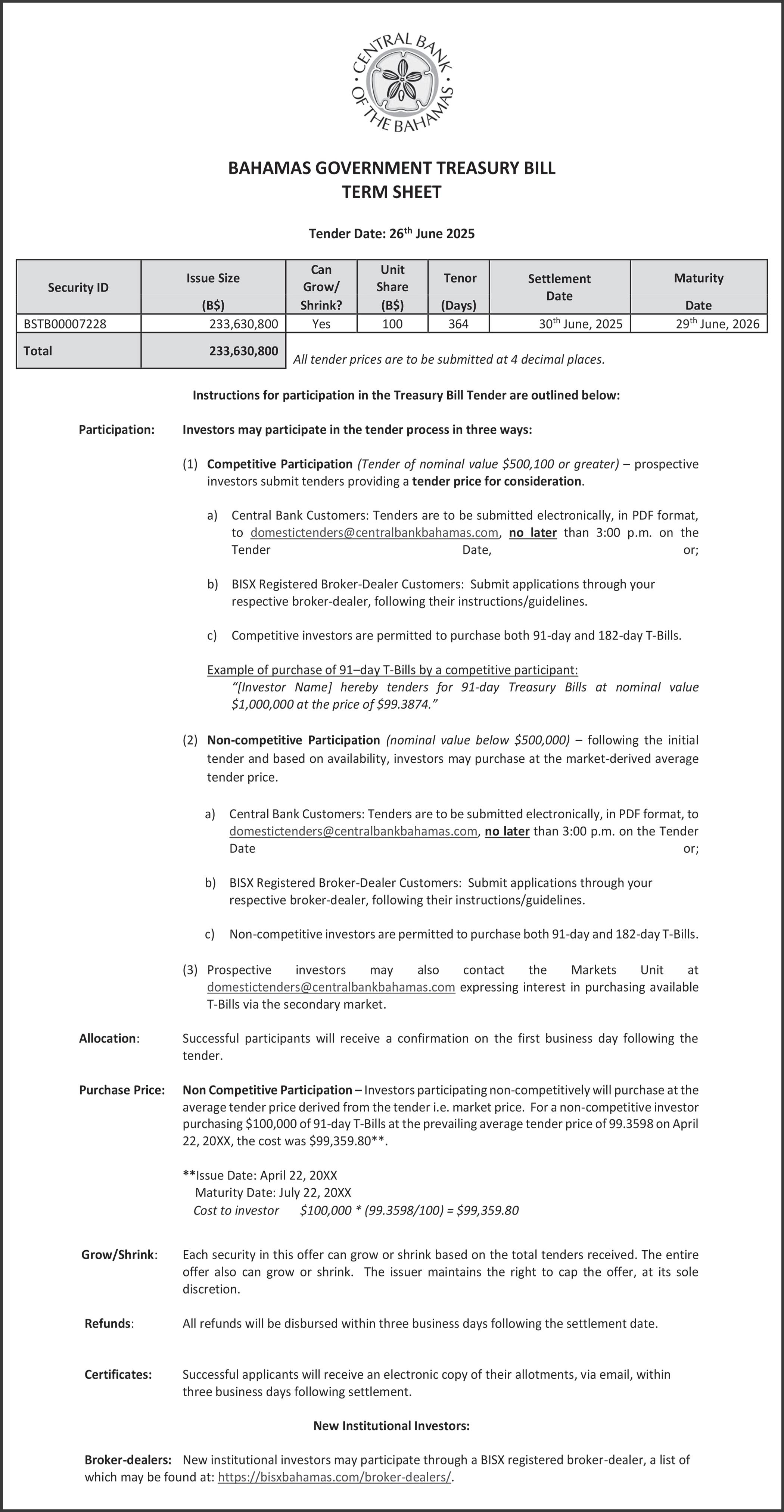
intact.
Every year, the environmental police team delivers its Performance & Justice Report—operations launched, arrests made, assets seized, fines collected, restoration funds allocated. An independent Audit Commission then audits expenses and training protocols, cementing transparency as non-negotiable.
Global partnerships and conventions
With domestic authority firmly in place, this force must also reach beyond our shores. As The Bahamas’ centralised reporting hub for all environmental enforcement data — filling a gap where today no unified system exists. A unified, interoperable platform will enable real-time cross-border intelligence — seizure logs, suspect profiles, vessel movements — eliminating the silos that currently hinder investigators.
This agency would monitor compliance of key conventions — CITES, the Convention on Biological Diversity, the Basel Convention, and the Protocol on Environmental Protection to UNCLOS — ensuring our domestic enforcement efforts align with global obligations.
A permanent liaison office would be exchanged with INTERPOL’s Environmental Crime Programme, NOAA, the US Fish and Wildlife Service, FWC, IMPACS, and other regional bodies to guarantee seamless information flow. These links would enable tracking of wildlife-trafficking syndicates, offshore illegal fishing fleets, and cross-border smuggling networks.
Joint task forces would leverage shared databases — INTERPOL’s Illicit Trade Reports, NOAA’s vessel-tracker systems, and CARICOM IMPACS data — to intercept suspicious cargoes and vessels before they reach The Bahamas. Memoranda of Understanding with partner agencies would outline protocols for evidence-sharing, extradition requests, and coordinated operations, ensuring that no loophole remains unsealed and no jurisdiction can be exploited by transnational offenders.
Forging a perpetual cadre
A permanent force requires permanent people, recruited, trained, and retained through an Environmental Field-Training Academy and dual recruitment pathways that blend cross-agency secondments from law enforcement, prosecutorial, and regulatory bodies with civilian specialists (data analysts, forensic biologists, cartographers, community liaisons).
All applicants would undergo a Basic Law Enforcement Aptitude Assessment and rigorous vetting before entering an intensive curriculum covering Bahamian statutes, international conventions, use-of-force ethics, physical conditioning for remote operations, and technical skills—including drone piloting, night-vision navigation, wildlife DNA sampling, and satellite and AIS analysis. No graduate would leave without meeting strict benchmarks in forensics, tactical operations, and community engagement, and every officer completes regular refresher training.
Clear career pathways guide roles from analysts to strategic advisors, biologists to instructors, and liaisons to outreach directors.
To maintain professionalism and innovation, two endowed chairs — in Environmental Law and Environmental Conservation Science — at the University of The Bahamas (funded by fines) will train recruits, spearhead research, and ensure academic rigor underpins all operations.
Arsenal for eternal vigilance The Environmental Crime Command Centre
would be the beating heart of the environmental police. It would be housed on a windowless command floor where 4K screens display satellite, drone, and AIS feeds in real time. Behind bulletproof glass and under hurricane-proof roofs, analysts process realtime data and issue rapid patrol directives. On Andros, Abaco, Exuma, Eleuthera, and Crooked Island, mini-command posts stand guard — positioned near fishing docks, mangrove estuaries, and illegal-mining hotspots. Built of local materials and engineered for Category 5 storms, they endure for decades with minimal upkeep and minimal environmental impact.
Soon after its enactment, the force would operate a modern fleet of shallow-draft patrol vessels outfitted with nightvision, infrared cameras, and onboard forensics labs capable of processing wildlife samples in the field. A high-speed interceptor would ensure any fleeing vessels are swiftly overtaken, while rugged allterrain vehicles equipped with satellite communications and scanners patrol remote shorelines and forested areas.
Fixed-wing drones provide long-endurance, multispectral surveillance for real-time habitat monitoring, and smaller thermal-imaging quadcopters enable rapid response to nighttime incidents.
Portable forensic kits — complete with DNA swabs and water-quality sensors — deliver immediate analysis on site, securing convictions before evidence can fade.
A dedicated Equipment Renewal Fund — capitalised by ten percent of every fine — would guarantee this arsenal never becomes obsolete. When new drone models emerge or remote-sensing technology advances, funding is already in place to upgrade without political debate.
A permanent institution
This environmental police force must be a permanent institution, founded on an Act that cannot be amended without a referendum and supported by a continual pipeline of rigorously trained personnel and cutting-edge equipment. Its legally invincible foundation would render it impervious to political interference, while officers — selected through transparent exams and trained to global best practices — would undergo annual refreshers to remain professionally unassailable.
With command centres, patrol vessels, and drones operating in concert, the agency would be technologically omnipresent across all protected zones.
Finally, transparently accountable mechanisms — public reports, community councils, and an open-source case portal — would ensure every action remains visible to every Bahamian.
This blueprint could remain as our nation’s unwavering promise: that no one will ever again plunder our last frontier — our ecosystems — uncontested. If we do not build this force now, clandestine kiln fires and habitat destruction will be the legacy we leave our children.
With that said, there is work for us all to do to see it through.
1. Legislators: Debate and pass this Bill immediately.
2. Policymakers: Fund bases, vessels, drones, and training — no excuses.
3. Citizens: Demand this force, volunteer when called, and hold leaders to account.
Because if we do not act now, we condemn our islands to an ever-shrinking frontier, stripped of its mangroves, its reefs, and its hope by locals and foreign actors alike. An environmental enforcement agency is not a mere aspiration. This is inevitable.

By Brian Bossak College of Charleston
SUMMER is just get-
ting started, and millions of people are under heat advisories as a major heat wave spreads across large parts of the central and eastern US in June 2025.
For many people, summer is their favorite season, a time for cookouts, beach trips and other outdoor activities. However, summer also brings the risk of dangerously high temperatures and humidity.
In the US, hundreds of people working or playing outside – even those who seem healthy – succumb to heat-related illnesses each year.
Older adults and people in areas that historically haven’t needed air conditioning tend to see the highest rates of illnesses during heat waves, as Chicago saw in 1995 when at least 700 people died in a heat wave.
Even in places where heat is recognised as a dangerous health threat, people can be caught off guard as the thermometer creeps higher, on average, each year. In some cases, dangerous heat can arise quickly. In 2021, a young family died of heat stroke on a California trail after setting out for a hike when temperatures were still in the 70s Fahrenheit (low to mid 20s Celsius).
I study health risks in a warming climate as a professor of public health, and I’ve seen heat become a growing concern. Here are some of the key warning signs to watch for when temperatures rise – and ways to keep cool when the heat and humidity get too high.
SIGNS OF HEAT-
Heat-related illnesses occur across a spectrum, and mild heat stress can quickly progress to lifethreatening heat stroke if a person is exposed to dangerous conditions for too long.
Mild forms of heatrelated illness include heat cramps and heat rash, both of which can be caused by extensive sweating during hot conditions. Cooling the body and drinking cool fluids can help.
When heat-related illnesses progress into heat exhaustion, the situation is more serious. Heat exhaustion includes symptoms such as dizziness, nausea, excessive sweating, feeling weak, thirst and getting a headache.
Heat exhaustion is a signal that the body is losing its ability to maintain a stable core temperature. Immediate action such as moving to a cool, ideally air-conditioned space, drinking liquids, loosening clothes and applying wet cloths are some of the recommended steps that can help keep heat exhaustion from progressing to the most dangerous form of heat-related illness, heat stroke.
Heat stroke is a medical emergency. At this point, the body can no longer maintain a stable core temperature. A body with heat stroke can reach 106 degrees Fahrenheit or higher rapidly, and that heat can quickly damage the brain, heart and kidneys. Typically, someone suffering heat stroke has exhausted their reserves of sweat and salt to stay cool, so sweating eventually stops during heat stroke. Their cognitive ability fails, and
they cannot remove themselves from danger. Heat stroke can cause seizures or put someone into a coma as their core temperature rises. If the condition is not treated immediately, and the core temperature continues to rise, heat stroke becomes fatal.
Because heat exhaustion can lead to heat stroke, addressing heat-related illnesses before they progress is vital.
Heat risk isn’t just about temperature – humidity also increases the risk of heatrelated illnesses because it affects how well sweating will cool the human body when it gets hot. Instead of just looking at temperature when planning outdoor activities, check the heat index, which accounts for heat illness risk associated with temperature and relative humidity. It doesn’t take very high temperatures or very high humidity for the heat index to enter dangerous territory. However, the heat index is still a conservative measure of the impact of heat on humans, particularly for outdoor workers and athletes at summer practices. This is because temperature measurements used in weather forecasting are taken in the shade and are not exposed to direct sunlight. If someone is outside and exposed to the direct sun, the actual heat index can be as much as 15 F higher than the heat index chart indicates.
A more sophisticated measurement of heat effects on human health is what’s known as the wet-bulb
“Illnesses can range from mild symptoms such as heat cramps and exhaustion to dizziness and fainting spells, to painful body cramps at the end of an extended exercise routine.
“If at any point you become confused, extremely drowsy or unconscious you need to seek emergency medical help. Heat stroke can be fatal if not treated properly.
“Vulnerable populations, including the elderly, children, and those with pre-existing health conditions, are particularly susceptible to these dangers.
“Health officials are advising the public to keep cool and well hydrated, limit time spent outdoors, wear light breathable clothing, wear a head covering and sunscreen.”
globe temperature, which takes into account other variables, such as wind speed and cloud cover. Neither takes into account a person’s physical exertion, which also raises their body temperature, whether working at a construction site or playing soccer.
How can you stay cool when heat waves set in?
The answer depends in part on where you are, but the main points are the same:
• Avoid strenuous outdoor activities in high temperatures if possible. If you start to feel symptoms of heat-related illnesses, drink fluids that will hydrate you. Find shade, rest, and use cool, damp cloths to lower your body temperature. If you see signs of heat stroke in someone else, call for medical help.
• Be careful with fans.
Fans can be useful if the temperature isn’t too high because they wick sweat away from the body and induce evaporative cooling. But at very high temperatures, they can accelerate heat buildup in the body and lead to
dangerous conditions. If indoor temperatures reaches 95 degrees or higher, using fans can actually be dangerous and raise the risk of heatrelated illnesses.
• Find a cooling centre, library or community center where you can get inside and rest in an airconditioned space in the hottest hours. In places such as Phoenix, where high temperatures are a regular hazard, cooling centres are typically opened in summer. Northern cities are also opening cooling centres as heat waves occur there more frequently than they did in the past. Urban areas with a lot of pavement and buildings – known as heat islands – can have temperatures well above the city’s average.
• Hydrate, hydrate, hydrate! Drink plenty of fluids, and don’t forget about the importance of electrolytes. Heat-related dehydration can occur when people sweat excessively, losing water and necessary salts from the body. Some sports drinks or rehydration fluids restore electrolytes and hydration levels.
Older adults and people with disabilities often face higher risks from heat waves, particularly if they can’t easily move to a cooler environment. Communities and neighbours can help protect vulnerable populations by providing cooling centres and bottled water and making regular wellness checks during high heat.
Summer can be a season of fun. Just remember the risks, keep an eye on your friends and neighbours when temperatures rise, and plan ahead so you can beat the heat.
•

By the Associated Press
THE United States inserted itself into Israel’s war against Iran by dropping 30,000-pound bombs on a uranium enrichment site early on Sunday, raising urgent questions about what remains of Tehran’s nuclear program and how its weakened military might respond.
Iran lashed out at the US for crossing “a very big red line” with its risky decision to launch strikes on three Iranian nuclear sites with missiles and bunker-buster bombs.
“The US has attacked us; what would you do in such a situation? Naturally, they must receive a response to their aggression,” Iranian President Masoud Pezeshkian said during a call with France’s leader, according to the president’s website.
Ali Akbar Velayati, an adviser to Iran’s supreme leader, said any country used by the US to strike Iran “will be a legitimate target for our armed forces,” the state-run IRNA
news agency reported. Amid fears of a wider regional conflict, the Trump administration sent a clear message that it wanted to restart diplomatic talks with Iran. “Let’s meet directly,” Secretary of State Marco Rubio said in an interview with CBS. Defense Secretary Pete Hegseth told reporters that the US “does not seek war.”
But Tehran said the time for diplomacy had passed and that it has the right to defend itself. Iranian Foreign Minister Abbas Araghchi said he would immediately fly to Moscow to coordinate with close ally Russia.
President Donald Trump earlier warned there would be additional strikes if Tehran retaliated against US forces. Tens of thousands of American troops are based in the Middle East. “There will either be peace or there will be tragedy for Iran,” said Trump, who acted without congressional authorisation.
The Atomic Energy Organization of Iran
confirmed that attacks took place on the Fordo and Natanz enrichment facilities, as well as the Isfahan nuclear site. Both Iran and the UN nuclear watchdog said there were no immediate signs of radioactive contamination around the sites.
Trump claimed the US “completely and fully obliterated” the sites, but the Pentagon reported “sustained, extremely severe damage and destruction.” Israeli army spokesman Effie Defrin said “the damage is deep,” but an assessment with the US continued.
“We are very close to achieving our goals” in removing the nuclear and missile threats, Israeli Prime Minister Benjamin Netanyahu said late on Sunday.
With the attack, the United States has inserted itself into a war it spent decades trying to avoid.
Success could mean ending Iran’s nuclear ambitions and eliminating the last significant state threat to the
security of Israel, its close ally. Failure — or overreach — could plunge the US into another long and unpredictable conflict.
For Iran’s supreme leader, it could mark the end of a campaign to transform the Islamic Republic into a greater regional power that holds enriched nuclear material a step away from weapons-grade. Ayatollah Ali Khamenei last spoke publicly on Wednesday, warning the US that strikes targeting the Islamic Republic will “result in irreparable damage for them”. Iran, battered by Israel’s largest-ever assault on it that began on June 13, has limited ways it could retaliate, as key allies have mostly stayed out of the conflict. It could launch a wave of attacks on US forces stationed in the Middle East with the missiles and rockets that Israel hasn’t destroyed. It could attempt to close a key bottleneck for global oil supplies, the Strait of Hormuz, between it and the
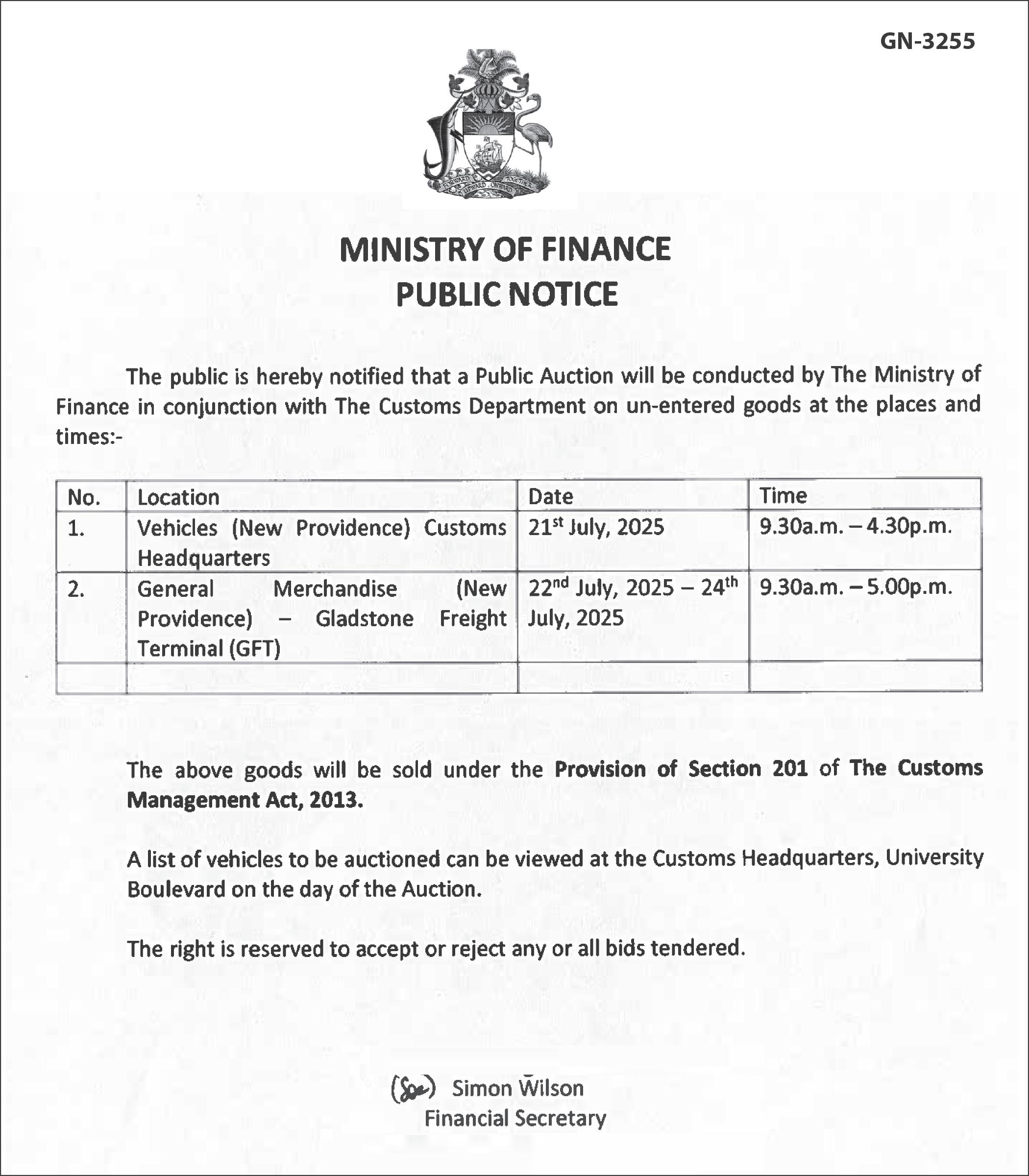
United Arab Emirates. Or it could hurry to develop a nuclear weapon with what remains of its program. The Atomic Energy Organization of Iran insisted that its nuclear program will not be stopped. Iran has long maintained that its nuclear program was peaceful, and US intelligence agencies have assessed that Tehran is not actively pursuing a bomb. However, Trump and Israeli leaders have argued that Iran could quickly assemble a nuclear weapon.
Israel has significantly degraded Iran’s air defenses and offensive missile capabilities and damaged its nuclear enrichment facilities. But only the US military has the bunkerbuster bombs that officials believe offered the best chance of destroying sites deep underground.
A total of 14 of the bombs were used on Natanz and Fordo, according to the Pentagon. Air Force Gen. Dan Caine, chairman of the Joint Chiefs of Staff, said 75 precision-guided weapons were used, including missiles fired from a submarine.
The strike on Fordo, which is dug deep into a mountain, raised an urgent question: What has happened to Iran’s stockpile of uranium and centrifuges?
Satellite images taken by Planet Labs PBC after the US strikes, analysed by The Associated Press, show damage to the facility.
The images suggest Iran packed the entrance tunnels to Fordo with dirt and had trucks at the facility ahead of the strikes.
Several Iranian officials, including Atomic Energy Organization of Iran spokesman Behrouz Kamalvandi, have claimed Iran removed nuclear material from targeted sites.
Before the Israeli military campaign began, Iran said it had declared a third, unknown site as a new enrichment facility.
“Questions remain as to where Iran may be storing its already enriched stocks … as these will have almost certainly been moved to hardened and undisclosed locations, out of the way of potential Israeli or US strikes,” said Darya Dolzikova, a senior research fellow at the Royal United Services Institute focused on nonproliferation issues.
“It is also unclear what secret facilities may exist inside Iran that Tehran could use” for weaponsrelated activities.
The International Atomic Energy Agency did not respond to a request for comment about Iran possibly moving nuclear material. The head of UN’s nuclear watchdog said he will convene an emergency meeting of the Board of
Governors on Monday. Global leaders responded with shock and calls for restraint. The United Nations Security Council was holding an emergency meeting Sunday. Egypt warned of “grave repercussions” for the region. Bahrain, home to the US Navy’s Middle East-based Fifth Fleet, called on Iran and the US to “quickly resume talks”.
The decision to attack was a risky one for Trump, who won the White House partly on the promise of keeping America out of costly foreign conflicts.
But Trump also vowed that he would not allow Iran to obtain a nuclear weapon. He initially hoped that the threat of force would bring the country’s leaders to give up its nuclear programme. For Netanyahu, the strikes were the culmination of a decades-long campaign to get the US to strike Israel’s chief regional rival and its disputed nuclear program. Netanyahu praised Trump, saying his decision “will change history”.
Israel is widely believed to be the only Middle Eastern country with nuclear weapons, but the country has never acknowledged it.
Israel’s military chief, Lt Gen Eyal Amir, called the US attack a key “turning point” but added: “We still have targets to strike and objectives to complete.”
Iran’s paramilitary Revolutionary Guard said it launched a barrage of 40 missiles at Israel, including its Khorramshahr-4, which can carry multiple warheads. Israeli authorities reported that more than 80 people suffered mostly minor injuries.
Late on Sunday, the Israeli military said it again struck military infrastructure sites in Tehran and western Iran.
Explosions boomed in the afternoon in the port city of Bushehr, home to Iran’s only nuclear power plant, three semi-official media outlets reported. Israel’s military said it struck missile launchers in Bushehr, Isfahan and Ahvaz, as well as a missile command center in the Yazd area where it said Khorramshahr missiles were stored.
Israeli strikes on Iran have killed at least 865 people and wounded 3,396 others, according to the Washington-based group Human Rights Activists. The group said of those dead, it identified 363 civilians and 215 security force personnel.
At Turkey’s border with Iran, one departing Iranian defended his country’s nuclear programme.
“We were minding our own business,” Behnam Puran said.
At least 24 people in Israel have been killed and over 1,000 wounded.
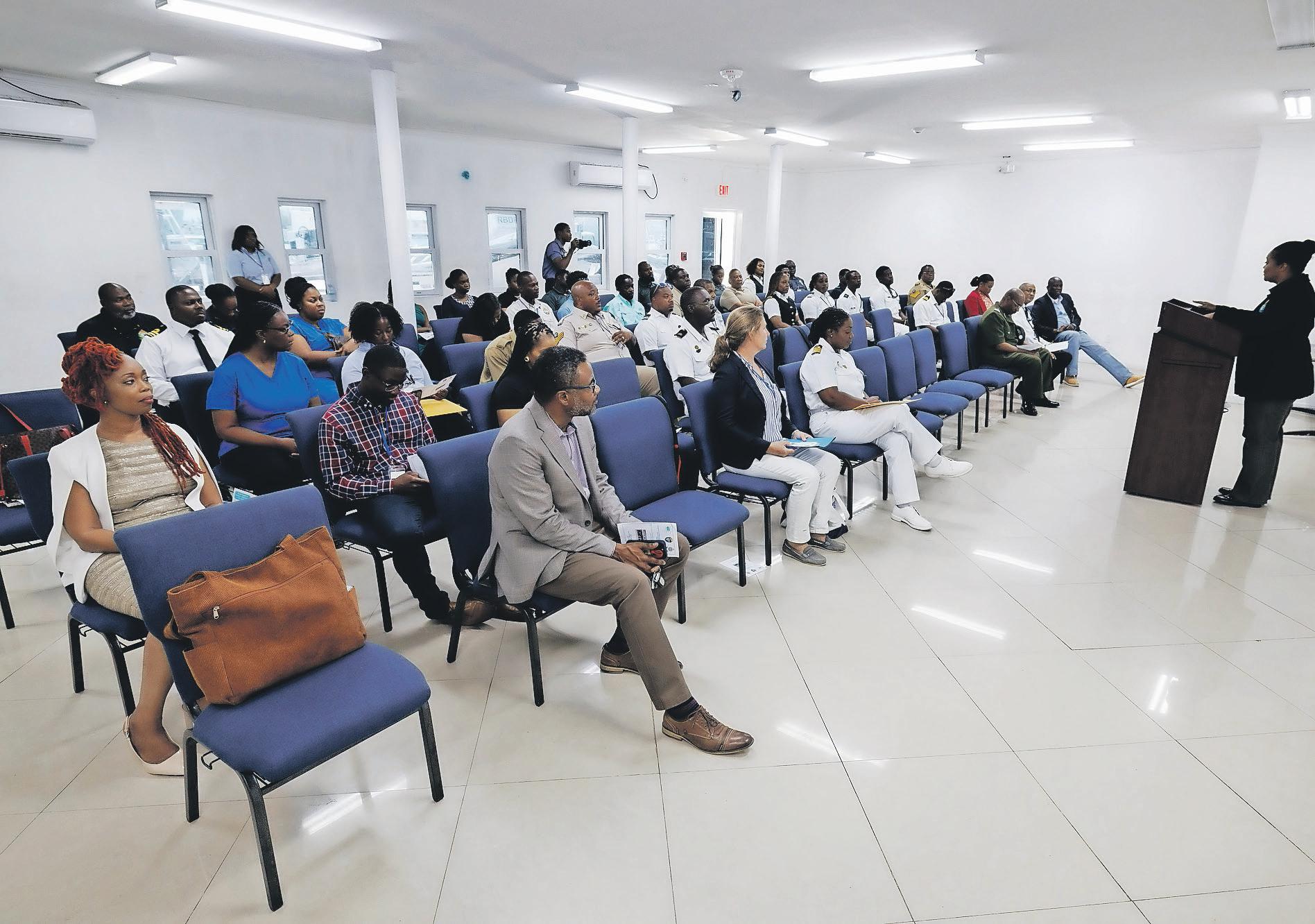
MORE than 30 officers from across The Bahamas’ enforcement and environmental agencies completed an intensive marine conservation training last week, part of a growing push to integrate science and enforcement in the protection of the country’s fragile marine ecosystems.
The week-long workshop, held from June 16 to 20 at HMBS Coral Harbour Base, was hosted by the Bahamas Reef Environment Educational Foundation (BREEF), in partnership with the Bahamas Wildlife Enforcement Network (BahWEN) and the Royal Bahamas Defence Force (RBDF). It marked the sixth such training event, aimed at enhancing collaboration among agencies and boosting conservation capacity.
Participants included personnel from the RBDF, BahWEN, Department of Marine Resources, Department of Environmental Planning and Protection, Customs, Immigration, Corrections, the Bahamas National Trust, the Airport Authority and Nassau Airport Development Company.
The training combined classroom instruction with practical fieldwork, covering topics such as plastic pollution, invasive species, CITES regulations, and climate change. Participants also learned marine species identification and enforcement principles related to fisheries laws. Daily snorkelling sessions at the BREEF Coral Reef Sculpture Garden and Coral Nursery reinforced classroom lessons with hands-on experience.
“BREEF is pleased to collaborate with BahWEN and the RBDF to host this
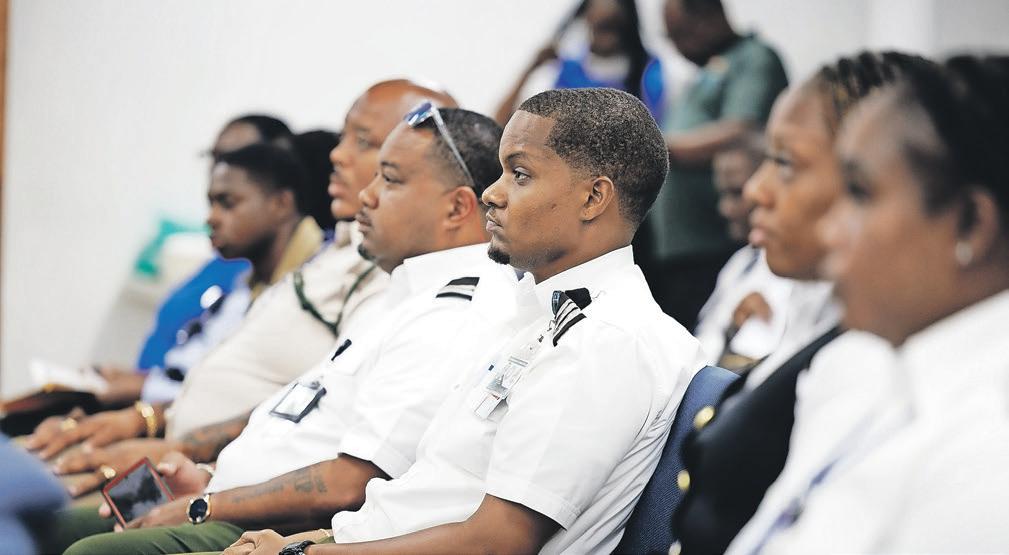
ATTNDEES at the Bahamas Reef Environment Educational Foundation (BREEF) marine conservation workshop, at which director Casuarina McKinny-Lambert, below, spoke during
ceremony.

workshop bringing together a variety of law enforcement personnel who all have a critical role to play protecting our marine heritage,” said BREEF executive director Casuarina McKinney-Lambert. “As an archipelago a healthy marine environment is essential to sustaining our lives and way of life.”
The workshop was supported by the Bonefish and Tarpon Trust, Moore Bahamas Foundation, Builders Initiative, and Primat Foundation.
THE Good Life Bahamas has earned its first Pacific Southwest Emmy Award nomination for its collaboration in Staycation: Bahamas, part of the popular travel and lifestyle series Staycation.
The nominated episode features an unprecedented full segment focused entirely on The Good Life Bahamas, making it the first time the series has dedicated a chapter exclusively to one brand.
The show highlights the company’s take on island living in The Bahamas, showcasing its approach to Bahamian hospitality, real estate services, and luxury vacation experiences.
The nomination recognises contributors including Robert Parks-Valletta, Valentina Ezeiza, Peter Whitehead, Kendall Kellaway III, Thomas Volker, Neil Fernandez, Alberto Lopez, and Making It Media.
The production team captured four of The Good Life Bahamas’ featured properties — Peeps
Cottage, Bahari, Cable Beach House, and Dune House — along with the local experiences that set the brand apart.
“This is more than just a nomination — it’s a celebration of The Bahamas, our vibrant culture, and the genuine warmth we share with every guest and homebuyer,” said a spokesperson from The Good Life Bahamas.
“Whether you’re searching for a real estate agent in The Bahamas, planning your dream island getaway, or looking to invest in Bahamian property, we’re proud to showcase what makes our islands so extraordinary.”
This is the first Emmy nomination for The Good Life Bahamas, and possibly the first for a Bahamasbased vacation rental and real estate brand.
The episode offers a rare glimpse into life on Exuma, Harbour Island, and Nassau — inviting travelers, homebuyers, and investors to discover a lifestyle rooted in serenity, connection, and authenticity.
